Understanding Atheroma Disease and its Prevention
VerifiedAdded on 2020/10/05
|27
|8190
|79
AI Summary
This assignment provides an in-depth look at atheroma disease, its causes, symptoms, and effects on overall health. It includes a questionnaire for students to assess their awareness and understanding of the disease, as well as potential risks and prevention methods. The assignment also touches on the importance of regular medical check-ups and healthy habits in preventing atheroma disease.
Contribute Materials
Your contribution can guide someone’s learning journey. Share your
documents today.

Research Project in the Health
and Social Care Setting
and Social Care Setting
Secure Best Marks with AI Grader
Need help grading? Try our AI Grader for instant feedback on your assignments.
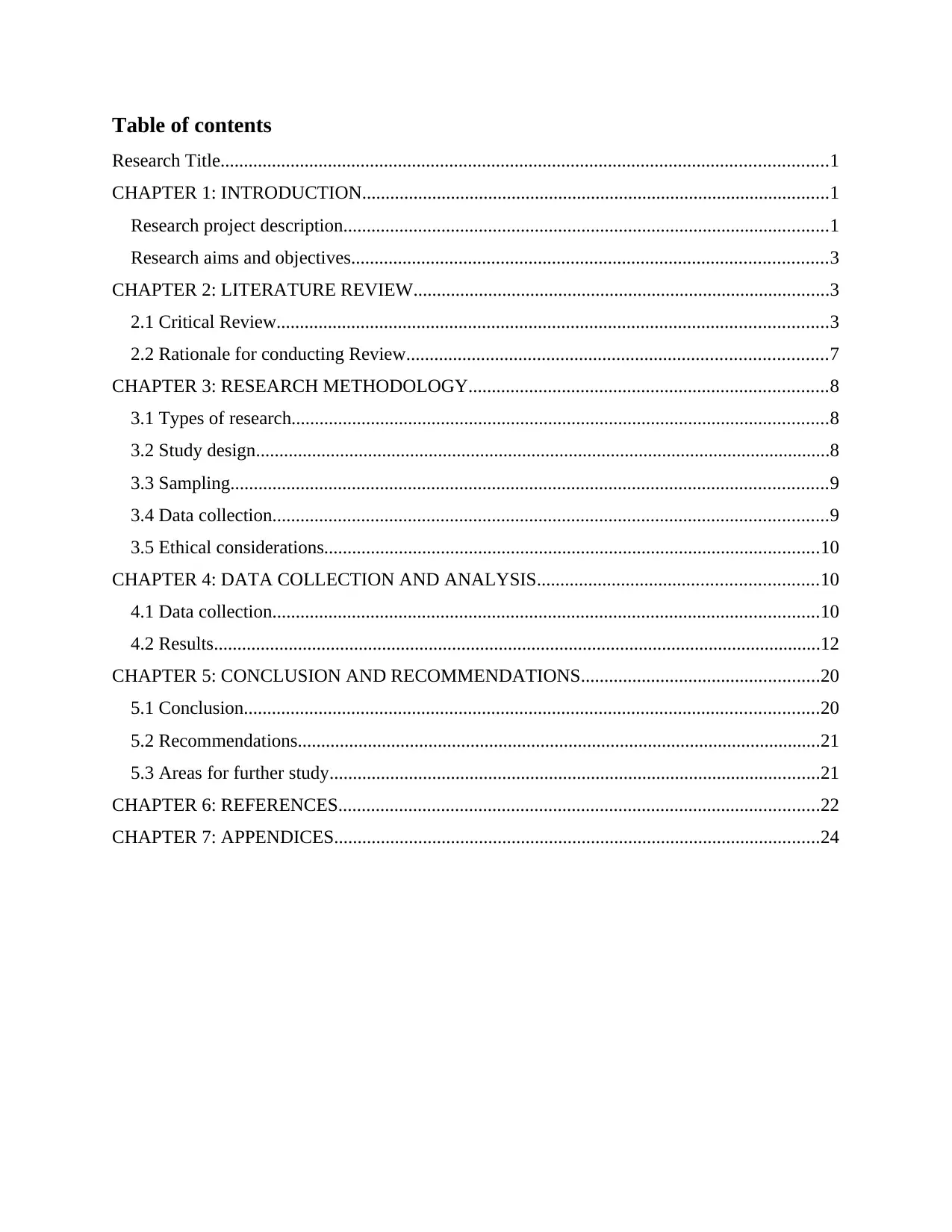
Table of contents
Research Title..................................................................................................................................1
CHAPTER 1: INTRODUCTION....................................................................................................1
Research project description........................................................................................................1
Research aims and objectives......................................................................................................3
CHAPTER 2: LITERATURE REVIEW.........................................................................................3
2.1 Critical Review......................................................................................................................3
2.2 Rationale for conducting Review..........................................................................................7
CHAPTER 3: RESEARCH METHODOLOGY.............................................................................8
3.1 Types of research...................................................................................................................8
3.2 Study design...........................................................................................................................8
3.3 Sampling................................................................................................................................9
3.4 Data collection.......................................................................................................................9
3.5 Ethical considerations..........................................................................................................10
CHAPTER 4: DATA COLLECTION AND ANALYSIS............................................................10
4.1 Data collection.....................................................................................................................10
4.2 Results..................................................................................................................................12
CHAPTER 5: CONCLUSION AND RECOMMENDATIONS...................................................20
5.1 Conclusion...........................................................................................................................20
5.2 Recommendations................................................................................................................21
5.3 Areas for further study.........................................................................................................21
CHAPTER 6: REFERENCES.......................................................................................................22
CHAPTER 7: APPENDICES........................................................................................................24
Research Title..................................................................................................................................1
CHAPTER 1: INTRODUCTION....................................................................................................1
Research project description........................................................................................................1
Research aims and objectives......................................................................................................3
CHAPTER 2: LITERATURE REVIEW.........................................................................................3
2.1 Critical Review......................................................................................................................3
2.2 Rationale for conducting Review..........................................................................................7
CHAPTER 3: RESEARCH METHODOLOGY.............................................................................8
3.1 Types of research...................................................................................................................8
3.2 Study design...........................................................................................................................8
3.3 Sampling................................................................................................................................9
3.4 Data collection.......................................................................................................................9
3.5 Ethical considerations..........................................................................................................10
CHAPTER 4: DATA COLLECTION AND ANALYSIS............................................................10
4.1 Data collection.....................................................................................................................10
4.2 Results..................................................................................................................................12
CHAPTER 5: CONCLUSION AND RECOMMENDATIONS...................................................20
5.1 Conclusion...........................................................................................................................20
5.2 Recommendations................................................................................................................21
5.3 Areas for further study.........................................................................................................21
CHAPTER 6: REFERENCES.......................................................................................................22
CHAPTER 7: APPENDICES........................................................................................................24
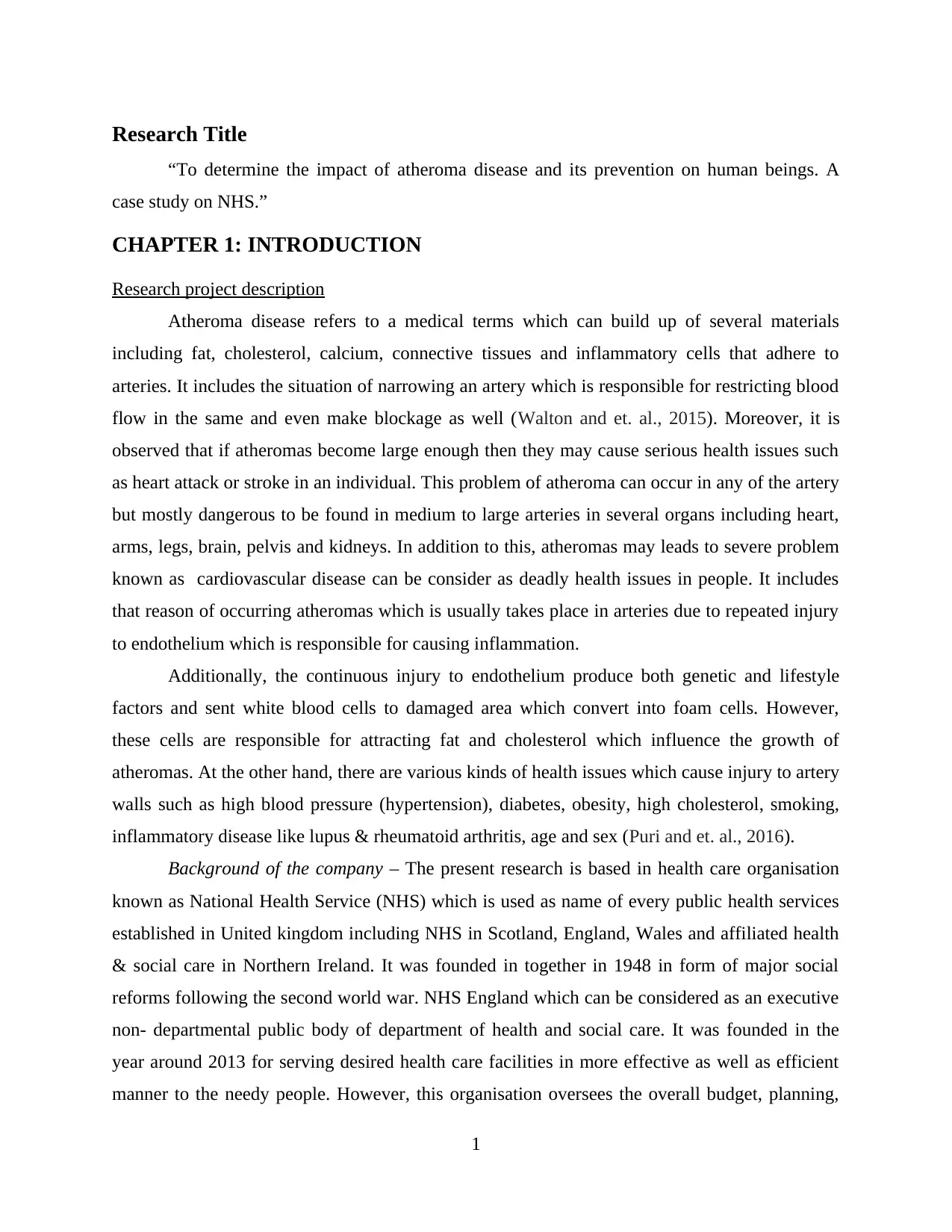
Research Title
“To determine the impact of atheroma disease and its prevention on human beings. A
case study on NHS.”
CHAPTER 1: INTRODUCTION
Research project description
Atheroma disease refers to a medical terms which can build up of several materials
including fat, cholesterol, calcium, connective tissues and inflammatory cells that adhere to
arteries. It includes the situation of narrowing an artery which is responsible for restricting blood
flow in the same and even make blockage as well (Walton and et. al., 2015). Moreover, it is
observed that if atheromas become large enough then they may cause serious health issues such
as heart attack or stroke in an individual. This problem of atheroma can occur in any of the artery
but mostly dangerous to be found in medium to large arteries in several organs including heart,
arms, legs, brain, pelvis and kidneys. In addition to this, atheromas may leads to severe problem
known as cardiovascular disease can be consider as deadly health issues in people. It includes
that reason of occurring atheromas which is usually takes place in arteries due to repeated injury
to endothelium which is responsible for causing inflammation.
Additionally, the continuous injury to endothelium produce both genetic and lifestyle
factors and sent white blood cells to damaged area which convert into foam cells. However,
these cells are responsible for attracting fat and cholesterol which influence the growth of
atheromas. At the other hand, there are various kinds of health issues which cause injury to artery
walls such as high blood pressure (hypertension), diabetes, obesity, high cholesterol, smoking,
inflammatory disease like lupus & rheumatoid arthritis, age and sex (Puri and et. al., 2016).
Background of the company – The present research is based in health care organisation
known as National Health Service (NHS) which is used as name of every public health services
established in United kingdom including NHS in Scotland, England, Wales and affiliated health
& social care in Northern Ireland. It was founded in together in 1948 in form of major social
reforms following the second world war. NHS England which can be considered as an executive
non- departmental public body of department of health and social care. It was founded in the
year around 2013 for serving desired health care facilities in more effective as well as efficient
manner to the needy people. However, this organisation oversees the overall budget, planning,
1
“To determine the impact of atheroma disease and its prevention on human beings. A
case study on NHS.”
CHAPTER 1: INTRODUCTION
Research project description
Atheroma disease refers to a medical terms which can build up of several materials
including fat, cholesterol, calcium, connective tissues and inflammatory cells that adhere to
arteries. It includes the situation of narrowing an artery which is responsible for restricting blood
flow in the same and even make blockage as well (Walton and et. al., 2015). Moreover, it is
observed that if atheromas become large enough then they may cause serious health issues such
as heart attack or stroke in an individual. This problem of atheroma can occur in any of the artery
but mostly dangerous to be found in medium to large arteries in several organs including heart,
arms, legs, brain, pelvis and kidneys. In addition to this, atheromas may leads to severe problem
known as cardiovascular disease can be consider as deadly health issues in people. It includes
that reason of occurring atheromas which is usually takes place in arteries due to repeated injury
to endothelium which is responsible for causing inflammation.
Additionally, the continuous injury to endothelium produce both genetic and lifestyle
factors and sent white blood cells to damaged area which convert into foam cells. However,
these cells are responsible for attracting fat and cholesterol which influence the growth of
atheromas. At the other hand, there are various kinds of health issues which cause injury to artery
walls such as high blood pressure (hypertension), diabetes, obesity, high cholesterol, smoking,
inflammatory disease like lupus & rheumatoid arthritis, age and sex (Puri and et. al., 2016).
Background of the company – The present research is based in health care organisation
known as National Health Service (NHS) which is used as name of every public health services
established in United kingdom including NHS in Scotland, England, Wales and affiliated health
& social care in Northern Ireland. It was founded in together in 1948 in form of major social
reforms following the second world war. NHS England which can be considered as an executive
non- departmental public body of department of health and social care. It was founded in the
year around 2013 for serving desired health care facilities in more effective as well as efficient
manner to the needy people. However, this organisation oversees the overall budget, planning,
1
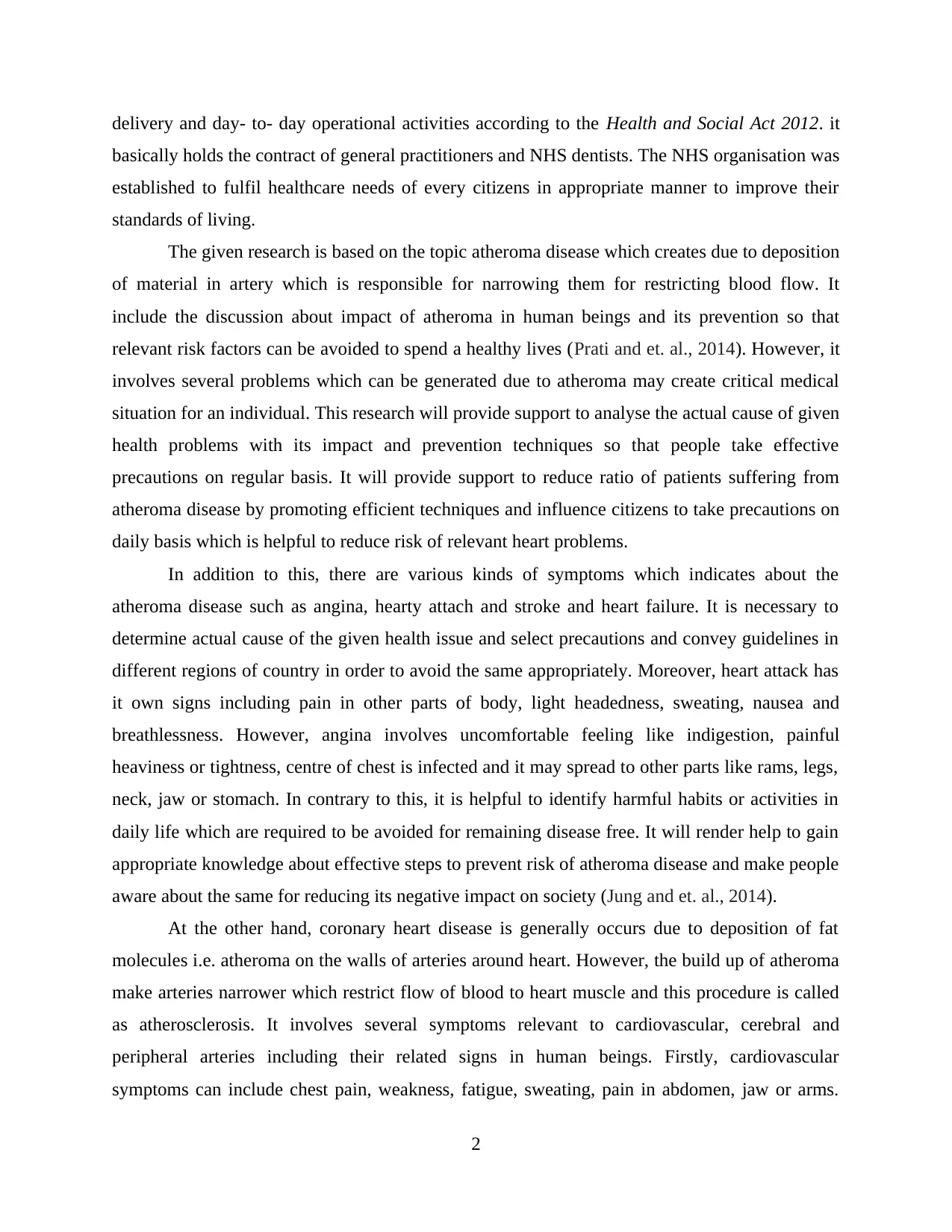
delivery and day- to- day operational activities according to the Health and Social Act 2012. it
basically holds the contract of general practitioners and NHS dentists. The NHS organisation was
established to fulfil healthcare needs of every citizens in appropriate manner to improve their
standards of living.
The given research is based on the topic atheroma disease which creates due to deposition
of material in artery which is responsible for narrowing them for restricting blood flow. It
include the discussion about impact of atheroma in human beings and its prevention so that
relevant risk factors can be avoided to spend a healthy lives (Prati and et. al., 2014). However, it
involves several problems which can be generated due to atheroma may create critical medical
situation for an individual. This research will provide support to analyse the actual cause of given
health problems with its impact and prevention techniques so that people take effective
precautions on regular basis. It will provide support to reduce ratio of patients suffering from
atheroma disease by promoting efficient techniques and influence citizens to take precautions on
daily basis which is helpful to reduce risk of relevant heart problems.
In addition to this, there are various kinds of symptoms which indicates about the
atheroma disease such as angina, hearty attach and stroke and heart failure. It is necessary to
determine actual cause of the given health issue and select precautions and convey guidelines in
different regions of country in order to avoid the same appropriately. Moreover, heart attack has
it own signs including pain in other parts of body, light headedness, sweating, nausea and
breathlessness. However, angina involves uncomfortable feeling like indigestion, painful
heaviness or tightness, centre of chest is infected and it may spread to other parts like rams, legs,
neck, jaw or stomach. In contrary to this, it is helpful to identify harmful habits or activities in
daily life which are required to be avoided for remaining disease free. It will render help to gain
appropriate knowledge about effective steps to prevent risk of atheroma disease and make people
aware about the same for reducing its negative impact on society (Jung and et. al., 2014).
At the other hand, coronary heart disease is generally occurs due to deposition of fat
molecules i.e. atheroma on the walls of arteries around heart. However, the build up of atheroma
make arteries narrower which restrict flow of blood to heart muscle and this procedure is called
as atherosclerosis. It involves several symptoms relevant to cardiovascular, cerebral and
peripheral arteries including their related signs in human beings. Firstly, cardiovascular
symptoms can include chest pain, weakness, fatigue, sweating, pain in abdomen, jaw or arms.
2
basically holds the contract of general practitioners and NHS dentists. The NHS organisation was
established to fulfil healthcare needs of every citizens in appropriate manner to improve their
standards of living.
The given research is based on the topic atheroma disease which creates due to deposition
of material in artery which is responsible for narrowing them for restricting blood flow. It
include the discussion about impact of atheroma in human beings and its prevention so that
relevant risk factors can be avoided to spend a healthy lives (Prati and et. al., 2014). However, it
involves several problems which can be generated due to atheroma may create critical medical
situation for an individual. This research will provide support to analyse the actual cause of given
health problems with its impact and prevention techniques so that people take effective
precautions on regular basis. It will provide support to reduce ratio of patients suffering from
atheroma disease by promoting efficient techniques and influence citizens to take precautions on
daily basis which is helpful to reduce risk of relevant heart problems.
In addition to this, there are various kinds of symptoms which indicates about the
atheroma disease such as angina, hearty attach and stroke and heart failure. It is necessary to
determine actual cause of the given health issue and select precautions and convey guidelines in
different regions of country in order to avoid the same appropriately. Moreover, heart attack has
it own signs including pain in other parts of body, light headedness, sweating, nausea and
breathlessness. However, angina involves uncomfortable feeling like indigestion, painful
heaviness or tightness, centre of chest is infected and it may spread to other parts like rams, legs,
neck, jaw or stomach. In contrary to this, it is helpful to identify harmful habits or activities in
daily life which are required to be avoided for remaining disease free. It will render help to gain
appropriate knowledge about effective steps to prevent risk of atheroma disease and make people
aware about the same for reducing its negative impact on society (Jung and et. al., 2014).
At the other hand, coronary heart disease is generally occurs due to deposition of fat
molecules i.e. atheroma on the walls of arteries around heart. However, the build up of atheroma
make arteries narrower which restrict flow of blood to heart muscle and this procedure is called
as atherosclerosis. It involves several symptoms relevant to cardiovascular, cerebral and
peripheral arteries including their related signs in human beings. Firstly, cardiovascular
symptoms can include chest pain, weakness, fatigue, sweating, pain in abdomen, jaw or arms.
2
Secure Best Marks with AI Grader
Need help grading? Try our AI Grader for instant feedback on your assignments.
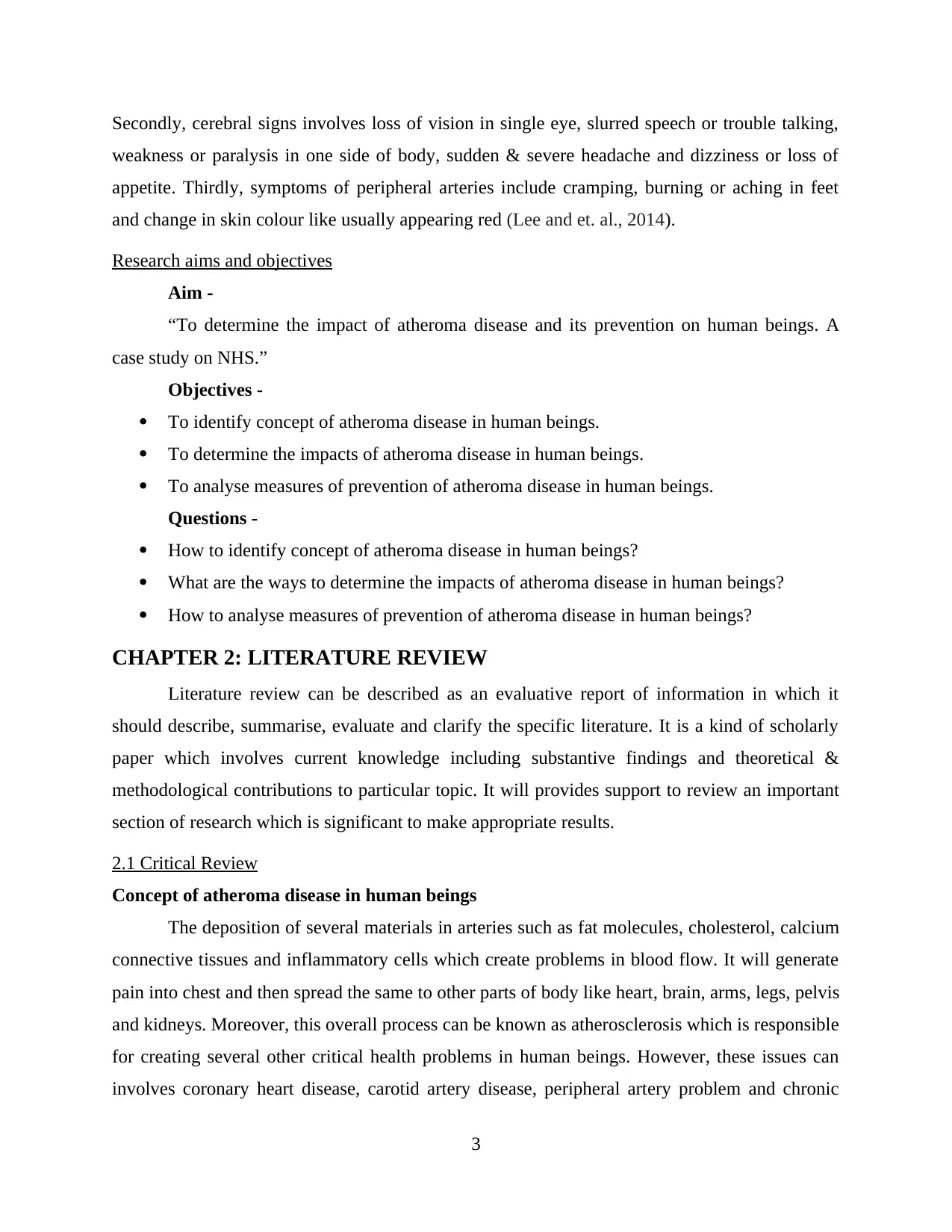
Secondly, cerebral signs involves loss of vision in single eye, slurred speech or trouble talking,
weakness or paralysis in one side of body, sudden & severe headache and dizziness or loss of
appetite. Thirdly, symptoms of peripheral arteries include cramping, burning or aching in feet
and change in skin colour like usually appearing red (Lee and et. al., 2014).
Research aims and objectives
Aim -
“To determine the impact of atheroma disease and its prevention on human beings. A
case study on NHS.”
Objectives -
To identify concept of atheroma disease in human beings.
To determine the impacts of atheroma disease in human beings.
To analyse measures of prevention of atheroma disease in human beings.
Questions -
How to identify concept of atheroma disease in human beings?
What are the ways to determine the impacts of atheroma disease in human beings?
How to analyse measures of prevention of atheroma disease in human beings?
CHAPTER 2: LITERATURE REVIEW
Literature review can be described as an evaluative report of information in which it
should describe, summarise, evaluate and clarify the specific literature. It is a kind of scholarly
paper which involves current knowledge including substantive findings and theoretical &
methodological contributions to particular topic. It will provides support to review an important
section of research which is significant to make appropriate results.
2.1 Critical Review
Concept of atheroma disease in human beings
The deposition of several materials in arteries such as fat molecules, cholesterol, calcium
connective tissues and inflammatory cells which create problems in blood flow. It will generate
pain into chest and then spread the same to other parts of body like heart, brain, arms, legs, pelvis
and kidneys. Moreover, this overall process can be known as atherosclerosis which is responsible
for creating several other critical health problems in human beings. However, these issues can
involves coronary heart disease, carotid artery disease, peripheral artery problem and chronic
3
weakness or paralysis in one side of body, sudden & severe headache and dizziness or loss of
appetite. Thirdly, symptoms of peripheral arteries include cramping, burning or aching in feet
and change in skin colour like usually appearing red (Lee and et. al., 2014).
Research aims and objectives
Aim -
“To determine the impact of atheroma disease and its prevention on human beings. A
case study on NHS.”
Objectives -
To identify concept of atheroma disease in human beings.
To determine the impacts of atheroma disease in human beings.
To analyse measures of prevention of atheroma disease in human beings.
Questions -
How to identify concept of atheroma disease in human beings?
What are the ways to determine the impacts of atheroma disease in human beings?
How to analyse measures of prevention of atheroma disease in human beings?
CHAPTER 2: LITERATURE REVIEW
Literature review can be described as an evaluative report of information in which it
should describe, summarise, evaluate and clarify the specific literature. It is a kind of scholarly
paper which involves current knowledge including substantive findings and theoretical &
methodological contributions to particular topic. It will provides support to review an important
section of research which is significant to make appropriate results.
2.1 Critical Review
Concept of atheroma disease in human beings
The deposition of several materials in arteries such as fat molecules, cholesterol, calcium
connective tissues and inflammatory cells which create problems in blood flow. It will generate
pain into chest and then spread the same to other parts of body like heart, brain, arms, legs, pelvis
and kidneys. Moreover, this overall process can be known as atherosclerosis which is responsible
for creating several other critical health problems in human beings. However, these issues can
involves coronary heart disease, carotid artery disease, peripheral artery problem and chronic
3

kidney disease which are severe health problems in people. In addition to this, it is not clear
about particular cause of atherosclerosis but it may generates due to certain traits, conditions or
habits which are responsible for creating risk of given health issue. Meanwhile, it is essential for
people to avoid harmful habits in their lifestyle like smoking, unhealthy diet and lack of physical
activity because it can be avoided with the help of changing daily habits.
(Source: What is Atherosclerosis, 2018)
At the other hand, atheroma disease is a kind of slow occurring problem which may start
in childhood but it is considered as complex disease as it can damage inner layers of arteries. As
per views of Kong (2018), there are several components which can create issue of atheroma
problems including smoke, high cholesterol or fats, high blood pressure and large amount of
sugar in blood. Moreover, it is analysed that plaque can begin to build up at those places where
arteries get damaged which makes them harden and narrower. Additionally, it has been analysed
that the blood cell fragments platelets gets stuck to location of injury in arteries which may
formulate into blood clots and results into less flow of oxygen rich blood to the body of human
beings.
4
Illustration 1: What is Atherosclerosis
about particular cause of atherosclerosis but it may generates due to certain traits, conditions or
habits which are responsible for creating risk of given health issue. Meanwhile, it is essential for
people to avoid harmful habits in their lifestyle like smoking, unhealthy diet and lack of physical
activity because it can be avoided with the help of changing daily habits.
(Source: What is Atherosclerosis, 2018)
At the other hand, atheroma disease is a kind of slow occurring problem which may start
in childhood but it is considered as complex disease as it can damage inner layers of arteries. As
per views of Kong (2018), there are several components which can create issue of atheroma
problems including smoke, high cholesterol or fats, high blood pressure and large amount of
sugar in blood. Moreover, it is analysed that plaque can begin to build up at those places where
arteries get damaged which makes them harden and narrower. Additionally, it has been analysed
that the blood cell fragments platelets gets stuck to location of injury in arteries which may
formulate into blood clots and results into less flow of oxygen rich blood to the body of human
beings.
4
Illustration 1: What is Atherosclerosis

In addition to to this, several risk factors are responsible for causing harm which are
relevant to atherosclerosis consisting clinical signs of cardiac and blood vessel ischaemic
pathology. According to the opinion of Leone (2018), it involves other elements like arrhythmias
and heart failure including metabolic signs which altered transportation of oxygen, pro- thrombic
changes of coagulation fibrinolysis cascade. Moreover, it also includes the sympathetic features
because of nerve stimulation which is responsible for arising modifications in heart rate as well
as blood pressure. There are various kinds of signs, symptoms and complications of
atherosclerosis which are analysed thoroughly in different types of arteries such as coronary ,
carotid, peripheral and renal including their own features.
The coronary arteries are helpful to supply oxygen rich blood to heart and narrowing of
the same create problems of angina which may spread to jaw, shoulders, arms, neck or back. It
also leads to problems of coronary heart disease with several signs including shortness of breathe
and arrhythmias. Moreover, the carotid artery problems can be analysed by various symptoms
such as sudden weakness, paralysis, confusion, trouble speaking, vision problem, breathing
issues, dizziness, trouble walking, loss of consciousness and sudden & severe headache.
Additionally, peripheral arteries create issues on flow of blood to legs, arms And pelvis which
results into numbness, pain and certain infections whereas renal artery damaging will create
kidney diseases having symptoms like tiredness, changes in urinate, loss of appetite, nausea,
trouble concentrating etc.
Impacts of atheroma disease in human beings
The atheroma include such material which deposit on the walls of arteries and make
narrower to restrict blood flow to different part of body. As per the point of view of Kholy
(2018), it includes various kinds of negative impacts on human body body such as vascular and
organs which get infected due to atheroma disease. However, it is observed that overall arteries
become down to 1mm diameter get affected and maximum atheroma takes place at the sites of
haemodynamic stress. There are several vascular consequences of this health problem including
its effects on vessels and organs of the human body. Moreover, it includes lumenal narrowing
cause ischaemia, lumenal occlusion results into infarction, embolism that is responsible for
ischaemia & infarction both and weakened wall causing aneurysm.
In addition to this, ischaemia is severe health issue and much narrowing can cause
symptoms such as chest pain on exertion due to narrowing of coronary artery which is also
5
relevant to atherosclerosis consisting clinical signs of cardiac and blood vessel ischaemic
pathology. According to the opinion of Leone (2018), it involves other elements like arrhythmias
and heart failure including metabolic signs which altered transportation of oxygen, pro- thrombic
changes of coagulation fibrinolysis cascade. Moreover, it also includes the sympathetic features
because of nerve stimulation which is responsible for arising modifications in heart rate as well
as blood pressure. There are various kinds of signs, symptoms and complications of
atherosclerosis which are analysed thoroughly in different types of arteries such as coronary ,
carotid, peripheral and renal including their own features.
The coronary arteries are helpful to supply oxygen rich blood to heart and narrowing of
the same create problems of angina which may spread to jaw, shoulders, arms, neck or back. It
also leads to problems of coronary heart disease with several signs including shortness of breathe
and arrhythmias. Moreover, the carotid artery problems can be analysed by various symptoms
such as sudden weakness, paralysis, confusion, trouble speaking, vision problem, breathing
issues, dizziness, trouble walking, loss of consciousness and sudden & severe headache.
Additionally, peripheral arteries create issues on flow of blood to legs, arms And pelvis which
results into numbness, pain and certain infections whereas renal artery damaging will create
kidney diseases having symptoms like tiredness, changes in urinate, loss of appetite, nausea,
trouble concentrating etc.
Impacts of atheroma disease in human beings
The atheroma include such material which deposit on the walls of arteries and make
narrower to restrict blood flow to different part of body. As per the point of view of Kholy
(2018), it includes various kinds of negative impacts on human body body such as vascular and
organs which get infected due to atheroma disease. However, it is observed that overall arteries
become down to 1mm diameter get affected and maximum atheroma takes place at the sites of
haemodynamic stress. There are several vascular consequences of this health problem including
its effects on vessels and organs of the human body. Moreover, it includes lumenal narrowing
cause ischaemia, lumenal occlusion results into infarction, embolism that is responsible for
ischaemia & infarction both and weakened wall causing aneurysm.
In addition to this, ischaemia is severe health issue and much narrowing can cause
symptoms such as chest pain on exertion due to narrowing of coronary artery which is also
5
Paraphrase This Document
Need a fresh take? Get an instant paraphrase of this document with our AI Paraphraser

considered medial situational called as angina. Secondly, lumenal occlusion occurs because of
thrombosis which can be results into infarction including problem of myocardial infarction in
coronary artery. Thirdly, issue of embolism generally takes place due to non- occludes distal
vessel in which cerebral ischaemic attacks because of embolism from carotid atheroma can be
included. As per opinion of Nakase (2018), it is atheroma is responsible fro another problems
known as aneurysm which is usually takes place in abdominal aorta so that aorta dilates will
become filled with lamellate thrombus and eventually get ruptured. However, a patient with
damaged aneurysm remain present with abdominal and back pain or even get shocked because of
blood loss in which immediate surgery is mandatory to resolve the same.
At the other hand, it has been analysed that atheroma is responsible for infecting various
organs such as heart, brain, kidneys, legs and gut. It involves a problem of angina which takes
place after narrowing of coronary arteries in human body and thrombic occlusion cause
myocardial infarction. Additionally, thrombic occlusion is also responsible for cerebral infarction
due to narrowed artery which impacts critically on an individual in terms of neurological deficit
and reduced conscious level. However, the precious impacts is based on site and size off
infarction in which is responsible for severity of relevant health issue. Moreover, atheroma cause
low blood supply to lower legs due to which an individual feel pain in calf on walking
claudication. At last but not least, the renal arteries generally have severe atheroma which
includes under perfused kidney which releases renin which is responsible for creation of renal
hypertension along with generating consequent risk of heart failure in human beings.
Measures of prevention of atheroma disease in human beings
There are various kinds of health problems which are required to be prevented or treated
to remain healthy and fit in order to spend comfortable life properly. On the basis of views of
Barton (2018), it involves the criteria of determining issues on time and take steps on daily basis
to avoid such medical problems for maintaining fitness of human being. Moreover, it is essential
to analyse overall those factors which are responsible for creating atheroma disease and change
lifestyle to avoid the same in terms of taking effective precautions in correct way. However, it
include several components such as smoking, high blood pressure, high cholesterol, family
history of atherosclerosis, inactive lifestyle, overweight or obesity, stress, excess alcohol intake,
lack physical exercise and diabetes. Meanwhile, these factors are required to be avoided by
taking appropriate precautions on regular basis to reduce risk of deposition of material to walls
6
thrombosis which can be results into infarction including problem of myocardial infarction in
coronary artery. Thirdly, issue of embolism generally takes place due to non- occludes distal
vessel in which cerebral ischaemic attacks because of embolism from carotid atheroma can be
included. As per opinion of Nakase (2018), it is atheroma is responsible fro another problems
known as aneurysm which is usually takes place in abdominal aorta so that aorta dilates will
become filled with lamellate thrombus and eventually get ruptured. However, a patient with
damaged aneurysm remain present with abdominal and back pain or even get shocked because of
blood loss in which immediate surgery is mandatory to resolve the same.
At the other hand, it has been analysed that atheroma is responsible for infecting various
organs such as heart, brain, kidneys, legs and gut. It involves a problem of angina which takes
place after narrowing of coronary arteries in human body and thrombic occlusion cause
myocardial infarction. Additionally, thrombic occlusion is also responsible for cerebral infarction
due to narrowed artery which impacts critically on an individual in terms of neurological deficit
and reduced conscious level. However, the precious impacts is based on site and size off
infarction in which is responsible for severity of relevant health issue. Moreover, atheroma cause
low blood supply to lower legs due to which an individual feel pain in calf on walking
claudication. At last but not least, the renal arteries generally have severe atheroma which
includes under perfused kidney which releases renin which is responsible for creation of renal
hypertension along with generating consequent risk of heart failure in human beings.
Measures of prevention of atheroma disease in human beings
There are various kinds of health problems which are required to be prevented or treated
to remain healthy and fit in order to spend comfortable life properly. On the basis of views of
Barton (2018), it involves the criteria of determining issues on time and take steps on daily basis
to avoid such medical problems for maintaining fitness of human being. Moreover, it is essential
to analyse overall those factors which are responsible for creating atheroma disease and change
lifestyle to avoid the same in terms of taking effective precautions in correct way. However, it
include several components such as smoking, high blood pressure, high cholesterol, family
history of atherosclerosis, inactive lifestyle, overweight or obesity, stress, excess alcohol intake,
lack physical exercise and diabetes. Meanwhile, these factors are required to be avoided by
taking appropriate precautions on regular basis to reduce risk of deposition of material to walls
6
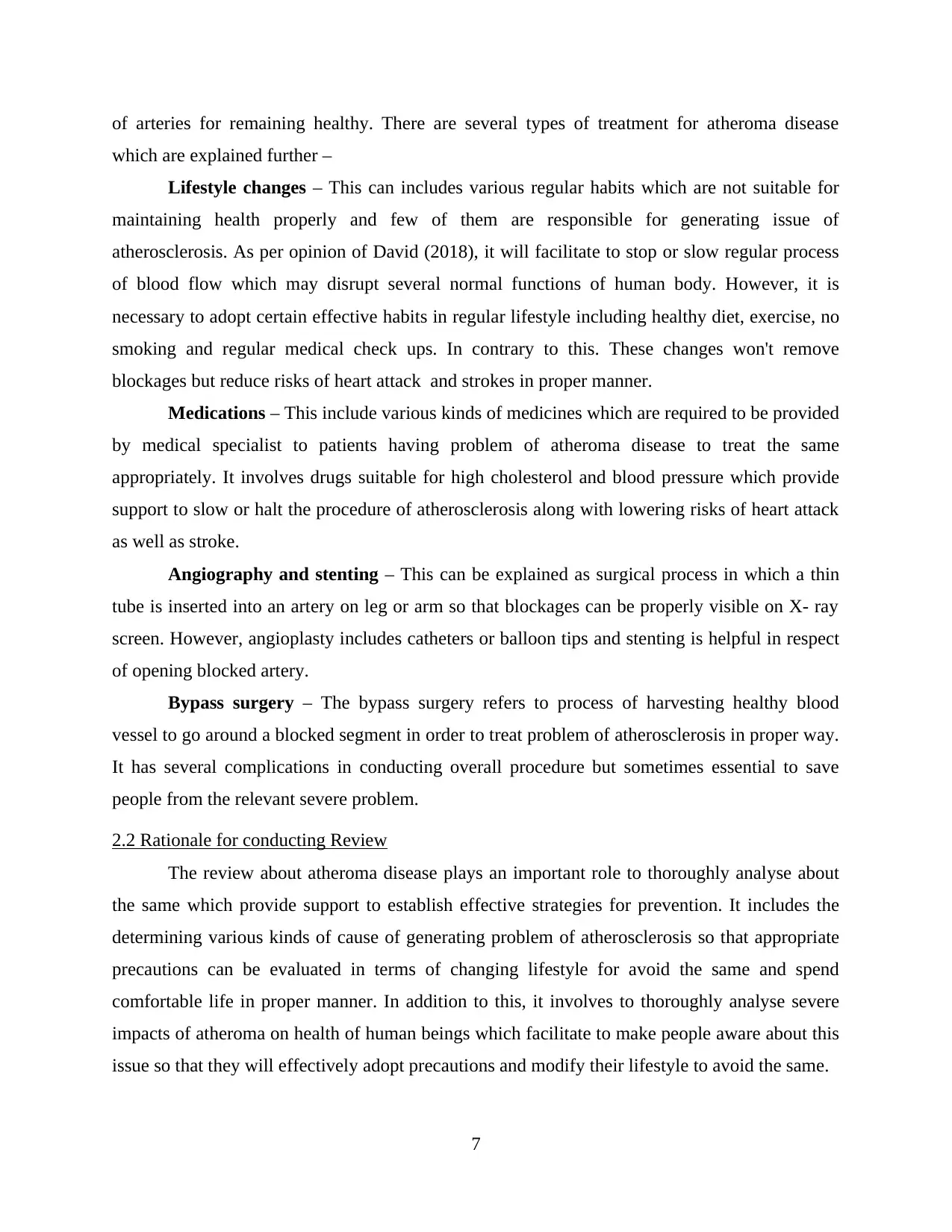
of arteries for remaining healthy. There are several types of treatment for atheroma disease
which are explained further –
Lifestyle changes – This can includes various regular habits which are not suitable for
maintaining health properly and few of them are responsible for generating issue of
atherosclerosis. As per opinion of David (2018), it will facilitate to stop or slow regular process
of blood flow which may disrupt several normal functions of human body. However, it is
necessary to adopt certain effective habits in regular lifestyle including healthy diet, exercise, no
smoking and regular medical check ups. In contrary to this. These changes won't remove
blockages but reduce risks of heart attack and strokes in proper manner.
Medications – This include various kinds of medicines which are required to be provided
by medical specialist to patients having problem of atheroma disease to treat the same
appropriately. It involves drugs suitable for high cholesterol and blood pressure which provide
support to slow or halt the procedure of atherosclerosis along with lowering risks of heart attack
as well as stroke.
Angiography and stenting – This can be explained as surgical process in which a thin
tube is inserted into an artery on leg or arm so that blockages can be properly visible on X- ray
screen. However, angioplasty includes catheters or balloon tips and stenting is helpful in respect
of opening blocked artery.
Bypass surgery – The bypass surgery refers to process of harvesting healthy blood
vessel to go around a blocked segment in order to treat problem of atherosclerosis in proper way.
It has several complications in conducting overall procedure but sometimes essential to save
people from the relevant severe problem.
2.2 Rationale for conducting Review
The review about atheroma disease plays an important role to thoroughly analyse about
the same which provide support to establish effective strategies for prevention. It includes the
determining various kinds of cause of generating problem of atherosclerosis so that appropriate
precautions can be evaluated in terms of changing lifestyle for avoid the same and spend
comfortable life in proper manner. In addition to this, it involves to thoroughly analyse severe
impacts of atheroma on health of human beings which facilitate to make people aware about this
issue so that they will effectively adopt precautions and modify their lifestyle to avoid the same.
7
which are explained further –
Lifestyle changes – This can includes various regular habits which are not suitable for
maintaining health properly and few of them are responsible for generating issue of
atherosclerosis. As per opinion of David (2018), it will facilitate to stop or slow regular process
of blood flow which may disrupt several normal functions of human body. However, it is
necessary to adopt certain effective habits in regular lifestyle including healthy diet, exercise, no
smoking and regular medical check ups. In contrary to this. These changes won't remove
blockages but reduce risks of heart attack and strokes in proper manner.
Medications – This include various kinds of medicines which are required to be provided
by medical specialist to patients having problem of atheroma disease to treat the same
appropriately. It involves drugs suitable for high cholesterol and blood pressure which provide
support to slow or halt the procedure of atherosclerosis along with lowering risks of heart attack
as well as stroke.
Angiography and stenting – This can be explained as surgical process in which a thin
tube is inserted into an artery on leg or arm so that blockages can be properly visible on X- ray
screen. However, angioplasty includes catheters or balloon tips and stenting is helpful in respect
of opening blocked artery.
Bypass surgery – The bypass surgery refers to process of harvesting healthy blood
vessel to go around a blocked segment in order to treat problem of atherosclerosis in proper way.
It has several complications in conducting overall procedure but sometimes essential to save
people from the relevant severe problem.
2.2 Rationale for conducting Review
The review about atheroma disease plays an important role to thoroughly analyse about
the same which provide support to establish effective strategies for prevention. It includes the
determining various kinds of cause of generating problem of atherosclerosis so that appropriate
precautions can be evaluated in terms of changing lifestyle for avoid the same and spend
comfortable life in proper manner. In addition to this, it involves to thoroughly analyse severe
impacts of atheroma on health of human beings which facilitate to make people aware about this
issue so that they will effectively adopt precautions and modify their lifestyle to avoid the same.
7
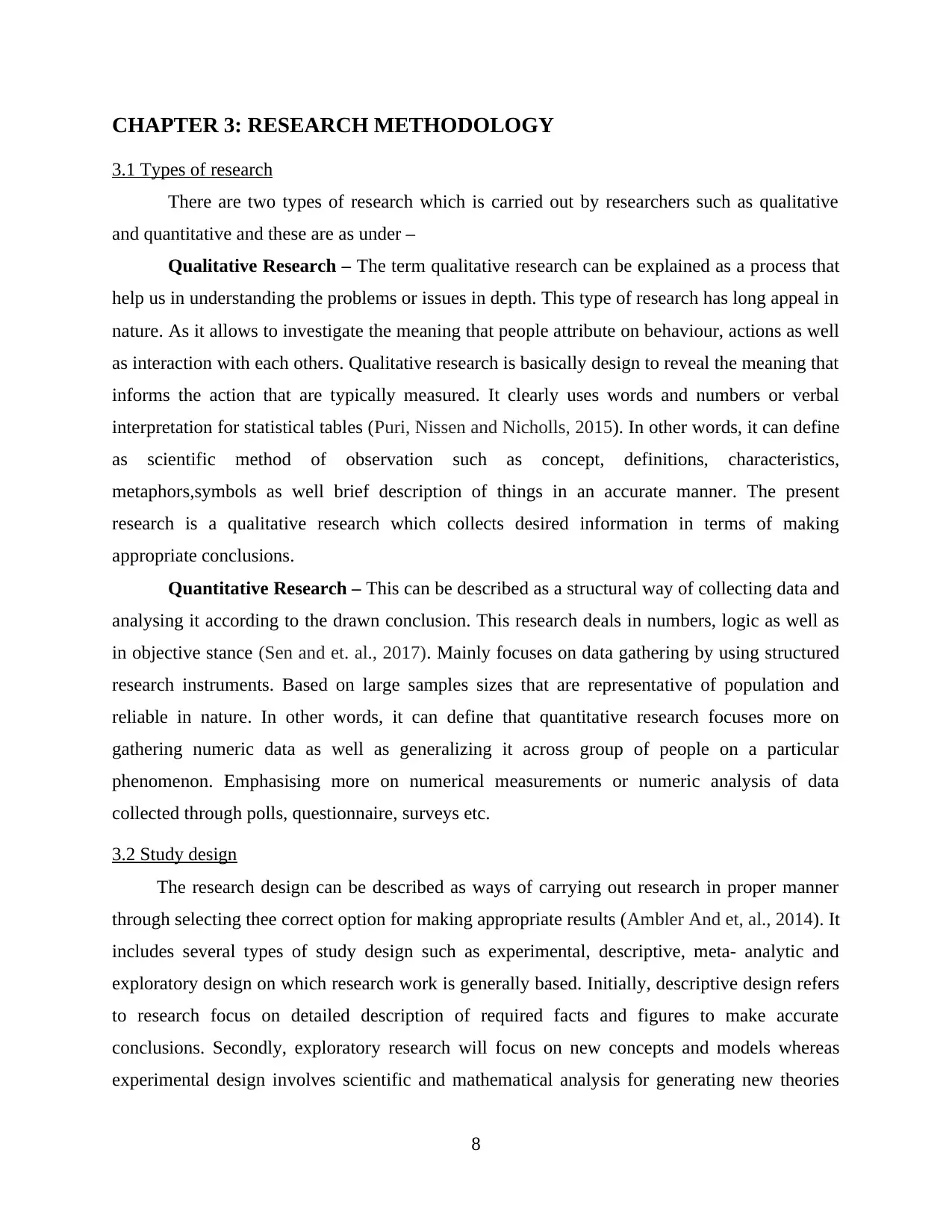
CHAPTER 3: RESEARCH METHODOLOGY
3.1 Types of research
There are two types of research which is carried out by researchers such as qualitative
and quantitative and these are as under –
Qualitative Research – The term qualitative research can be explained as a process that
help us in understanding the problems or issues in depth. This type of research has long appeal in
nature. As it allows to investigate the meaning that people attribute on behaviour, actions as well
as interaction with each others. Qualitative research is basically design to reveal the meaning that
informs the action that are typically measured. It clearly uses words and numbers or verbal
interpretation for statistical tables (Puri, Nissen and Nicholls, 2015). In other words, it can define
as scientific method of observation such as concept, definitions, characteristics,
metaphors,symbols as well brief description of things in an accurate manner. The present
research is a qualitative research which collects desired information in terms of making
appropriate conclusions.
Quantitative Research – This can be described as a structural way of collecting data and
analysing it according to the drawn conclusion. This research deals in numbers, logic as well as
in objective stance (Sen and et. al., 2017). Mainly focuses on data gathering by using structured
research instruments. Based on large samples sizes that are representative of population and
reliable in nature. In other words, it can define that quantitative research focuses more on
gathering numeric data as well as generalizing it across group of people on a particular
phenomenon. Emphasising more on numerical measurements or numeric analysis of data
collected through polls, questionnaire, surveys etc.
3.2 Study design
The research design can be described as ways of carrying out research in proper manner
through selecting thee correct option for making appropriate results (Ambler And et, al., 2014). It
includes several types of study design such as experimental, descriptive, meta- analytic and
exploratory design on which research work is generally based. Initially, descriptive design refers
to research focus on detailed description of required facts and figures to make accurate
conclusions. Secondly, exploratory research will focus on new concepts and models whereas
experimental design involves scientific and mathematical analysis for generating new theories
8
3.1 Types of research
There are two types of research which is carried out by researchers such as qualitative
and quantitative and these are as under –
Qualitative Research – The term qualitative research can be explained as a process that
help us in understanding the problems or issues in depth. This type of research has long appeal in
nature. As it allows to investigate the meaning that people attribute on behaviour, actions as well
as interaction with each others. Qualitative research is basically design to reveal the meaning that
informs the action that are typically measured. It clearly uses words and numbers or verbal
interpretation for statistical tables (Puri, Nissen and Nicholls, 2015). In other words, it can define
as scientific method of observation such as concept, definitions, characteristics,
metaphors,symbols as well brief description of things in an accurate manner. The present
research is a qualitative research which collects desired information in terms of making
appropriate conclusions.
Quantitative Research – This can be described as a structural way of collecting data and
analysing it according to the drawn conclusion. This research deals in numbers, logic as well as
in objective stance (Sen and et. al., 2017). Mainly focuses on data gathering by using structured
research instruments. Based on large samples sizes that are representative of population and
reliable in nature. In other words, it can define that quantitative research focuses more on
gathering numeric data as well as generalizing it across group of people on a particular
phenomenon. Emphasising more on numerical measurements or numeric analysis of data
collected through polls, questionnaire, surveys etc.
3.2 Study design
The research design can be described as ways of carrying out research in proper manner
through selecting thee correct option for making appropriate results (Ambler And et, al., 2014). It
includes several types of study design such as experimental, descriptive, meta- analytic and
exploratory design on which research work is generally based. Initially, descriptive design refers
to research focus on detailed description of required facts and figures to make accurate
conclusions. Secondly, exploratory research will focus on new concepts and models whereas
experimental design involves scientific and mathematical analysis for generating new theories
8
Secure Best Marks with AI Grader
Need help grading? Try our AI Grader for instant feedback on your assignments.

along with proving the same properly. Thirdly, the present report will focus on cause and
impacts of atheroma disease on human beings along with its prevention effectively. This research
can be said as descriptive design for analysing actual facts about atherosclerosis in proper
manner for making desired results.
3.3 Sampling
The sampling can be described as a statistical approach in business research in which pre
determined observation is perceived from the large population. It usually depends on the type of
analysis being performed while doing sampling. It is basically considered as a presentation of the
entire population and it is necessary to know how the sample is chosen at the time of conducting
the same procedure in proper manner. There are two techniques to perform sampling including
Systematic Sampling which uses a random starting point and a period interval to select items
from sampling. In addition to this, Simple Random Sampling which can be explained is as a
statistical analysis of the entire population in which a subset has an equal probability of being
chosen. The present research will utilise random sampling for collecting desired sample of 30
respondents in order to make appropriate conclusions (Frati, 2014).
3.4 Data collection
The data collection methods are given below –
Primary Research – The term primary research can be considered as a framework or
methodology which is used by researcher in order to collect data directly, rather than depending
on information gathered previously. One of the most advantage of this research is that it is
carried out only for specific purpose. It is designed to meet unique and specific needs of
researchers. In other words, it can define that data are original in nature are related to the issues
or problems. Researchers collects these data through various methods like interviews, surveys,
questionnaire etc. As these data are original in nature and create relevancy to the topic so that
appropriate results can be concluded in proper way.
Secondary research – This can be described as to gather data from previous records,
books, journals, articles, magazines, newspapers and many more (Karkhaneh and et. al., 2016). It
includes the previous data which provide correct direction for avoiding past issues and losses
which facilitate to achieve better profitability for business. The present research will utilise
secondary data collection method in order to conclude desired results in proper manner.
9
impacts of atheroma disease on human beings along with its prevention effectively. This research
can be said as descriptive design for analysing actual facts about atherosclerosis in proper
manner for making desired results.
3.3 Sampling
The sampling can be described as a statistical approach in business research in which pre
determined observation is perceived from the large population. It usually depends on the type of
analysis being performed while doing sampling. It is basically considered as a presentation of the
entire population and it is necessary to know how the sample is chosen at the time of conducting
the same procedure in proper manner. There are two techniques to perform sampling including
Systematic Sampling which uses a random starting point and a period interval to select items
from sampling. In addition to this, Simple Random Sampling which can be explained is as a
statistical analysis of the entire population in which a subset has an equal probability of being
chosen. The present research will utilise random sampling for collecting desired sample of 30
respondents in order to make appropriate conclusions (Frati, 2014).
3.4 Data collection
The data collection methods are given below –
Primary Research – The term primary research can be considered as a framework or
methodology which is used by researcher in order to collect data directly, rather than depending
on information gathered previously. One of the most advantage of this research is that it is
carried out only for specific purpose. It is designed to meet unique and specific needs of
researchers. In other words, it can define that data are original in nature are related to the issues
or problems. Researchers collects these data through various methods like interviews, surveys,
questionnaire etc. As these data are original in nature and create relevancy to the topic so that
appropriate results can be concluded in proper way.
Secondary research – This can be described as to gather data from previous records,
books, journals, articles, magazines, newspapers and many more (Karkhaneh and et. al., 2016). It
includes the previous data which provide correct direction for avoiding past issues and losses
which facilitate to achieve better profitability for business. The present research will utilise
secondary data collection method in order to conclude desired results in proper manner.
9
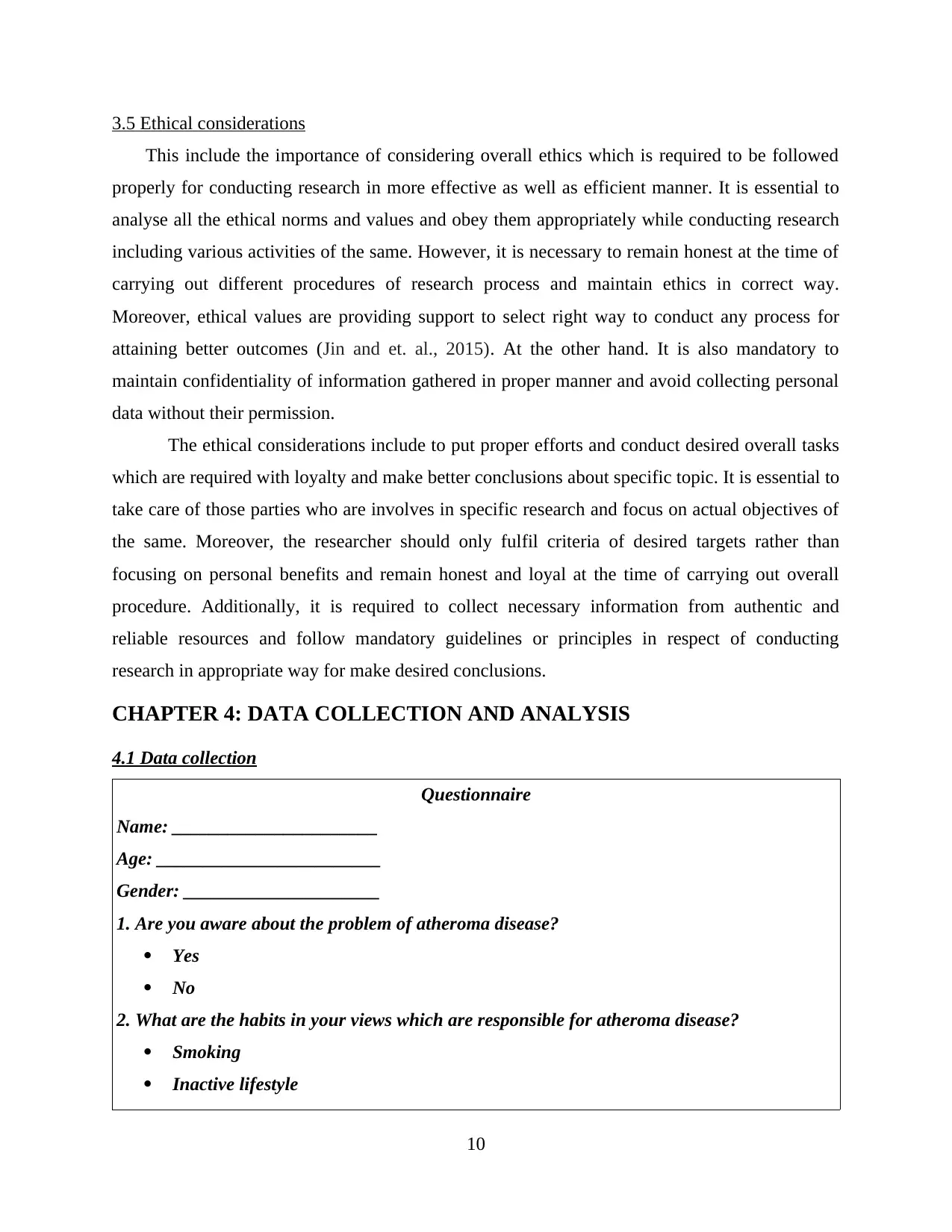
3.5 Ethical considerations
This include the importance of considering overall ethics which is required to be followed
properly for conducting research in more effective as well as efficient manner. It is essential to
analyse all the ethical norms and values and obey them appropriately while conducting research
including various activities of the same. However, it is necessary to remain honest at the time of
carrying out different procedures of research process and maintain ethics in correct way.
Moreover, ethical values are providing support to select right way to conduct any process for
attaining better outcomes (Jin and et. al., 2015). At the other hand. It is also mandatory to
maintain confidentiality of information gathered in proper manner and avoid collecting personal
data without their permission.
The ethical considerations include to put proper efforts and conduct desired overall tasks
which are required with loyalty and make better conclusions about specific topic. It is essential to
take care of those parties who are involves in specific research and focus on actual objectives of
the same. Moreover, the researcher should only fulfil criteria of desired targets rather than
focusing on personal benefits and remain honest and loyal at the time of carrying out overall
procedure. Additionally, it is required to collect necessary information from authentic and
reliable resources and follow mandatory guidelines or principles in respect of conducting
research in appropriate way for make desired conclusions.
CHAPTER 4: DATA COLLECTION AND ANALYSIS
4.1 Data collection
Questionnaire
Name: ______________________
Age: ________________________
Gender: _____________________
1. Are you aware about the problem of atheroma disease?
Yes
No
2. What are the habits in your views which are responsible for atheroma disease?
Smoking
Inactive lifestyle
10
This include the importance of considering overall ethics which is required to be followed
properly for conducting research in more effective as well as efficient manner. It is essential to
analyse all the ethical norms and values and obey them appropriately while conducting research
including various activities of the same. However, it is necessary to remain honest at the time of
carrying out different procedures of research process and maintain ethics in correct way.
Moreover, ethical values are providing support to select right way to conduct any process for
attaining better outcomes (Jin and et. al., 2015). At the other hand. It is also mandatory to
maintain confidentiality of information gathered in proper manner and avoid collecting personal
data without their permission.
The ethical considerations include to put proper efforts and conduct desired overall tasks
which are required with loyalty and make better conclusions about specific topic. It is essential to
take care of those parties who are involves in specific research and focus on actual objectives of
the same. Moreover, the researcher should only fulfil criteria of desired targets rather than
focusing on personal benefits and remain honest and loyal at the time of carrying out overall
procedure. Additionally, it is required to collect necessary information from authentic and
reliable resources and follow mandatory guidelines or principles in respect of conducting
research in appropriate way for make desired conclusions.
CHAPTER 4: DATA COLLECTION AND ANALYSIS
4.1 Data collection
Questionnaire
Name: ______________________
Age: ________________________
Gender: _____________________
1. Are you aware about the problem of atheroma disease?
Yes
No
2. What are the habits in your views which are responsible for atheroma disease?
Smoking
Inactive lifestyle
10
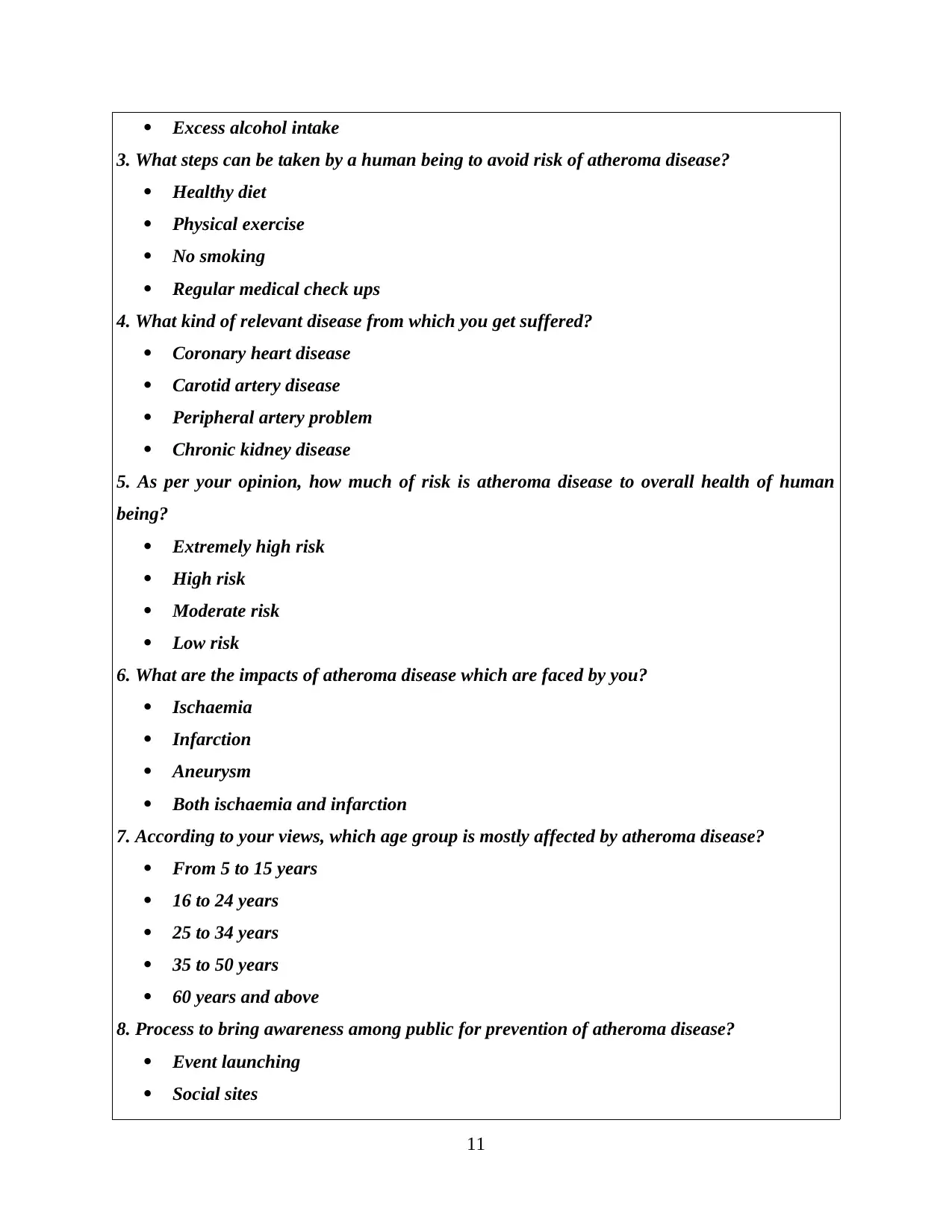
Excess alcohol intake
3. What steps can be taken by a human being to avoid risk of atheroma disease?
Healthy diet
Physical exercise
No smoking
Regular medical check ups
4. What kind of relevant disease from which you get suffered?
Coronary heart disease
Carotid artery disease
Peripheral artery problem
Chronic kidney disease
5. As per your opinion, how much of risk is atheroma disease to overall health of human
being?
Extremely high risk
High risk
Moderate risk
Low risk
6. What are the impacts of atheroma disease which are faced by you?
Ischaemia
Infarction
Aneurysm
Both ischaemia and infarction
7. According to your views, which age group is mostly affected by atheroma disease?
From 5 to 15 years
16 to 24 years
25 to 34 years
35 to 50 years
60 years and above
8. Process to bring awareness among public for prevention of atheroma disease?
Event launching
Social sites
11
3. What steps can be taken by a human being to avoid risk of atheroma disease?
Healthy diet
Physical exercise
No smoking
Regular medical check ups
4. What kind of relevant disease from which you get suffered?
Coronary heart disease
Carotid artery disease
Peripheral artery problem
Chronic kidney disease
5. As per your opinion, how much of risk is atheroma disease to overall health of human
being?
Extremely high risk
High risk
Moderate risk
Low risk
6. What are the impacts of atheroma disease which are faced by you?
Ischaemia
Infarction
Aneurysm
Both ischaemia and infarction
7. According to your views, which age group is mostly affected by atheroma disease?
From 5 to 15 years
16 to 24 years
25 to 34 years
35 to 50 years
60 years and above
8. Process to bring awareness among public for prevention of atheroma disease?
Event launching
Social sites
11
Paraphrase This Document
Need a fresh take? Get an instant paraphrase of this document with our AI Paraphraser
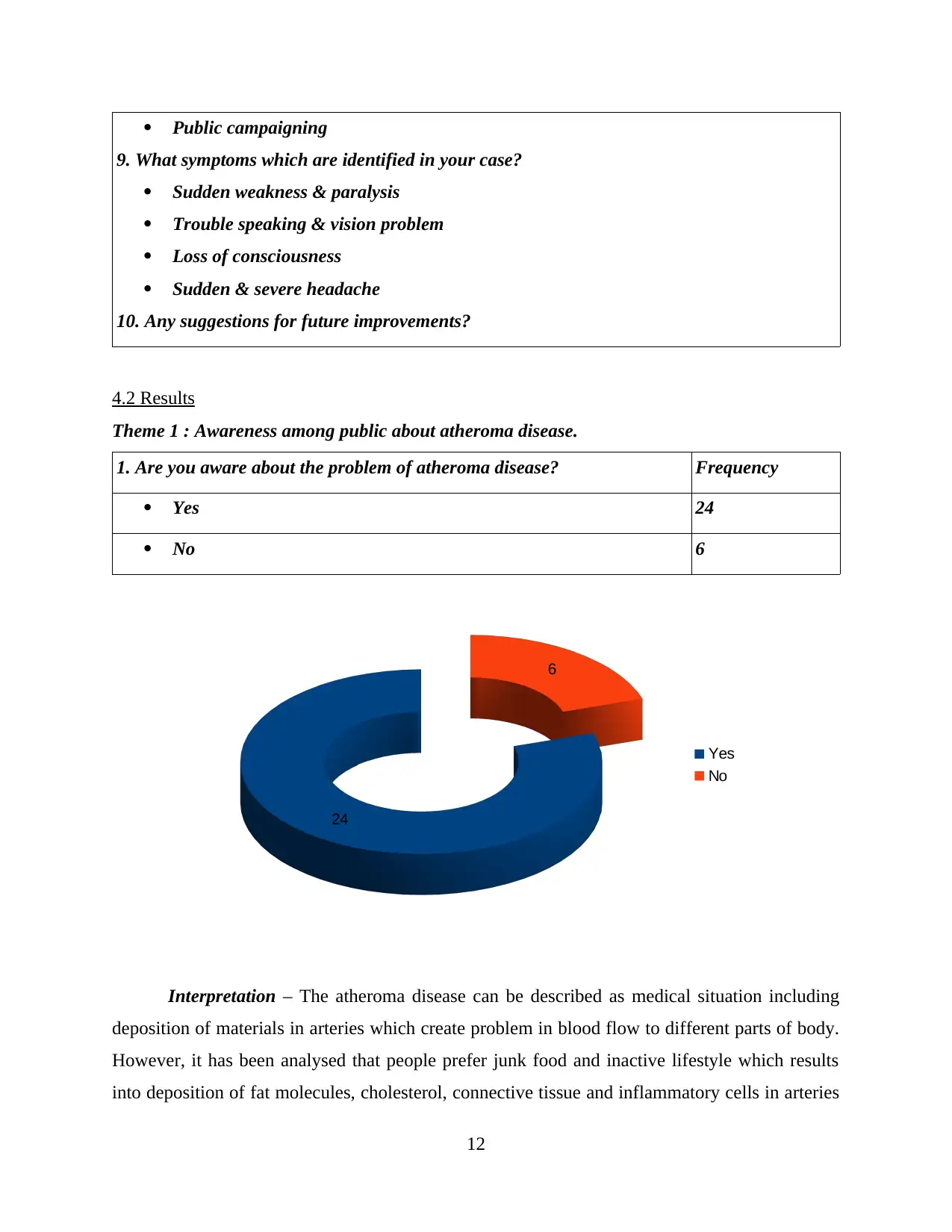
Public campaigning
9. What symptoms which are identified in your case?
Sudden weakness & paralysis
Trouble speaking & vision problem
Loss of consciousness
Sudden & severe headache
10. Any suggestions for future improvements?
4.2 Results
Theme 1 : Awareness among public about atheroma disease.
1. Are you aware about the problem of atheroma disease? Frequency
Yes 24
No 6
Interpretation – The atheroma disease can be described as medical situation including
deposition of materials in arteries which create problem in blood flow to different parts of body.
However, it has been analysed that people prefer junk food and inactive lifestyle which results
into deposition of fat molecules, cholesterol, connective tissue and inflammatory cells in arteries
12
24
6
Yes
No
9. What symptoms which are identified in your case?
Sudden weakness & paralysis
Trouble speaking & vision problem
Loss of consciousness
Sudden & severe headache
10. Any suggestions for future improvements?
4.2 Results
Theme 1 : Awareness among public about atheroma disease.
1. Are you aware about the problem of atheroma disease? Frequency
Yes 24
No 6
Interpretation – The atheroma disease can be described as medical situation including
deposition of materials in arteries which create problem in blood flow to different parts of body.
However, it has been analysed that people prefer junk food and inactive lifestyle which results
into deposition of fat molecules, cholesterol, connective tissue and inflammatory cells in arteries
12
24
6
Yes
No
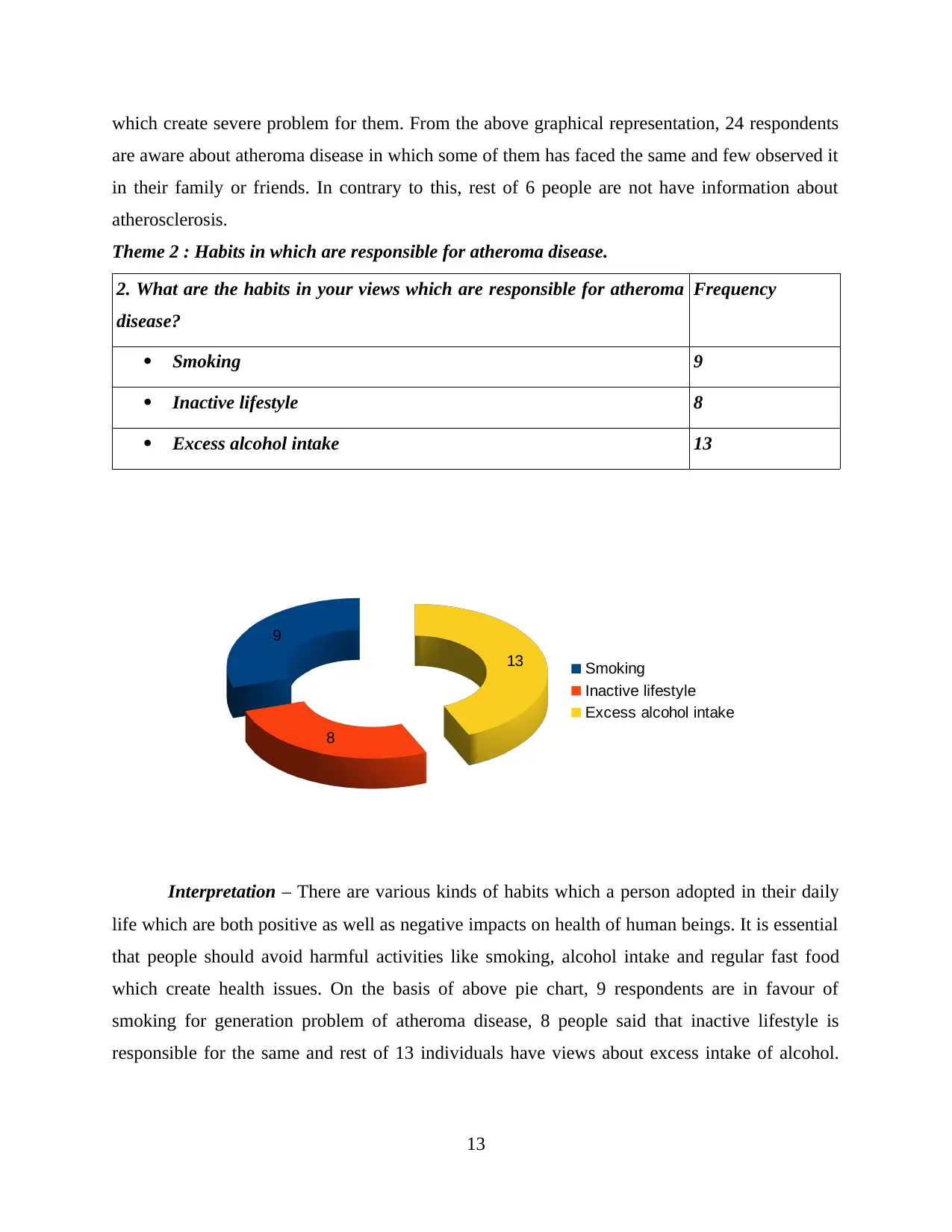
which create severe problem for them. From the above graphical representation, 24 respondents
are aware about atheroma disease in which some of them has faced the same and few observed it
in their family or friends. In contrary to this, rest of 6 people are not have information about
atherosclerosis.
Theme 2 : Habits in which are responsible for atheroma disease.
2. What are the habits in your views which are responsible for atheroma
disease?
Frequency
Smoking 9
Inactive lifestyle 8
Excess alcohol intake 13
Interpretation – There are various kinds of habits which a person adopted in their daily
life which are both positive as well as negative impacts on health of human beings. It is essential
that people should avoid harmful activities like smoking, alcohol intake and regular fast food
which create health issues. On the basis of above pie chart, 9 respondents are in favour of
smoking for generation problem of atheroma disease, 8 people said that inactive lifestyle is
responsible for the same and rest of 13 individuals have views about excess intake of alcohol.
13
9
8
13 Smoking
Inactive lifestyle
Excess alcohol intake
are aware about atheroma disease in which some of them has faced the same and few observed it
in their family or friends. In contrary to this, rest of 6 people are not have information about
atherosclerosis.
Theme 2 : Habits in which are responsible for atheroma disease.
2. What are the habits in your views which are responsible for atheroma
disease?
Frequency
Smoking 9
Inactive lifestyle 8
Excess alcohol intake 13
Interpretation – There are various kinds of habits which a person adopted in their daily
life which are both positive as well as negative impacts on health of human beings. It is essential
that people should avoid harmful activities like smoking, alcohol intake and regular fast food
which create health issues. On the basis of above pie chart, 9 respondents are in favour of
smoking for generation problem of atheroma disease, 8 people said that inactive lifestyle is
responsible for the same and rest of 13 individuals have views about excess intake of alcohol.
13
9
8
13 Smoking
Inactive lifestyle
Excess alcohol intake
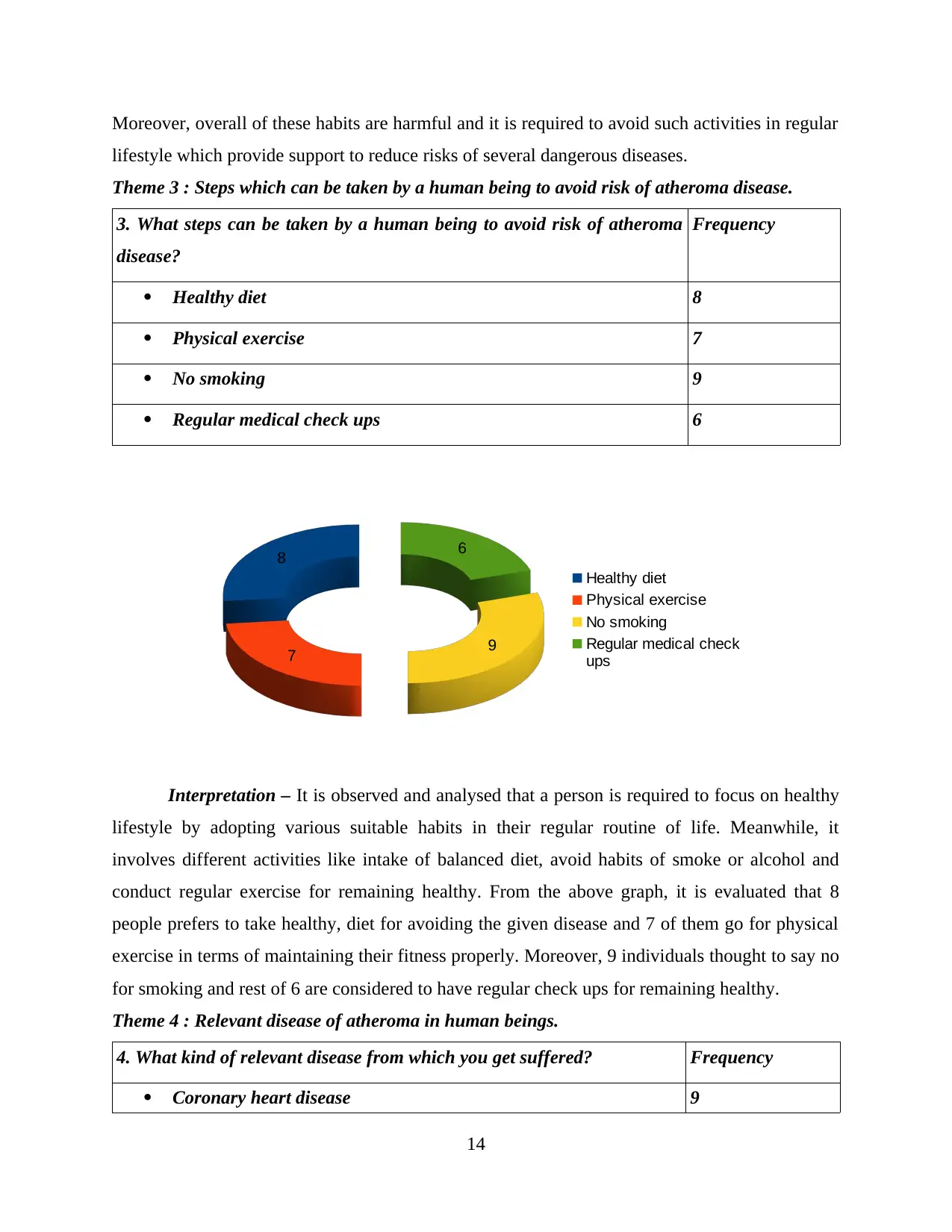
Moreover, overall of these habits are harmful and it is required to avoid such activities in regular
lifestyle which provide support to reduce risks of several dangerous diseases.
Theme 3 : Steps which can be taken by a human being to avoid risk of atheroma disease.
3. What steps can be taken by a human being to avoid risk of atheroma
disease?
Frequency
Healthy diet 8
Physical exercise 7
No smoking 9
Regular medical check ups 6
Interpretation – It is observed and analysed that a person is required to focus on healthy
lifestyle by adopting various suitable habits in their regular routine of life. Meanwhile, it
involves different activities like intake of balanced diet, avoid habits of smoke or alcohol and
conduct regular exercise for remaining healthy. From the above graph, it is evaluated that 8
people prefers to take healthy, diet for avoiding the given disease and 7 of them go for physical
exercise in terms of maintaining their fitness properly. Moreover, 9 individuals thought to say no
for smoking and rest of 6 are considered to have regular check ups for remaining healthy.
Theme 4 : Relevant disease of atheroma in human beings.
4. What kind of relevant disease from which you get suffered? Frequency
Coronary heart disease 9
14
8
7 9
6
Healthy diet
Physical exercise
No smoking
Regular medical check
ups
lifestyle which provide support to reduce risks of several dangerous diseases.
Theme 3 : Steps which can be taken by a human being to avoid risk of atheroma disease.
3. What steps can be taken by a human being to avoid risk of atheroma
disease?
Frequency
Healthy diet 8
Physical exercise 7
No smoking 9
Regular medical check ups 6
Interpretation – It is observed and analysed that a person is required to focus on healthy
lifestyle by adopting various suitable habits in their regular routine of life. Meanwhile, it
involves different activities like intake of balanced diet, avoid habits of smoke or alcohol and
conduct regular exercise for remaining healthy. From the above graph, it is evaluated that 8
people prefers to take healthy, diet for avoiding the given disease and 7 of them go for physical
exercise in terms of maintaining their fitness properly. Moreover, 9 individuals thought to say no
for smoking and rest of 6 are considered to have regular check ups for remaining healthy.
Theme 4 : Relevant disease of atheroma in human beings.
4. What kind of relevant disease from which you get suffered? Frequency
Coronary heart disease 9
14
8
7 9
6
Healthy diet
Physical exercise
No smoking
Regular medical check
ups
Secure Best Marks with AI Grader
Need help grading? Try our AI Grader for instant feedback on your assignments.
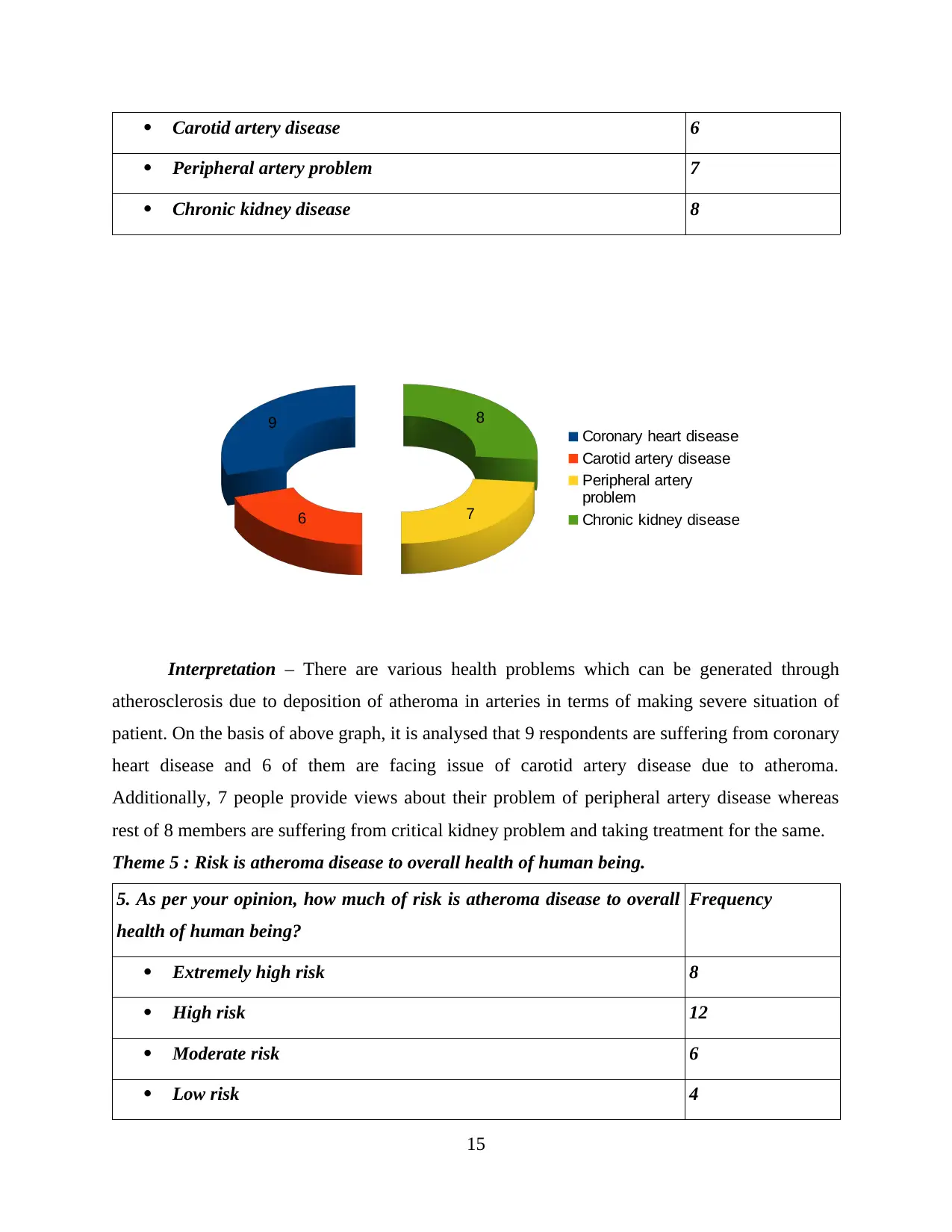
Carotid artery disease 6
Peripheral artery problem 7
Chronic kidney disease 8
Interpretation – There are various health problems which can be generated through
atherosclerosis due to deposition of atheroma in arteries in terms of making severe situation of
patient. On the basis of above graph, it is analysed that 9 respondents are suffering from coronary
heart disease and 6 of them are facing issue of carotid artery disease due to atheroma.
Additionally, 7 people provide views about their problem of peripheral artery disease whereas
rest of 8 members are suffering from critical kidney problem and taking treatment for the same.
Theme 5 : Risk is atheroma disease to overall health of human being.
5. As per your opinion, how much of risk is atheroma disease to overall
health of human being?
Frequency
Extremely high risk 8
High risk 12
Moderate risk 6
Low risk 4
15
9
6 7
8
Coronary heart disease
Carotid artery disease
Peripheral artery
problem
Chronic kidney disease
Peripheral artery problem 7
Chronic kidney disease 8
Interpretation – There are various health problems which can be generated through
atherosclerosis due to deposition of atheroma in arteries in terms of making severe situation of
patient. On the basis of above graph, it is analysed that 9 respondents are suffering from coronary
heart disease and 6 of them are facing issue of carotid artery disease due to atheroma.
Additionally, 7 people provide views about their problem of peripheral artery disease whereas
rest of 8 members are suffering from critical kidney problem and taking treatment for the same.
Theme 5 : Risk is atheroma disease to overall health of human being.
5. As per your opinion, how much of risk is atheroma disease to overall
health of human being?
Frequency
Extremely high risk 8
High risk 12
Moderate risk 6
Low risk 4
15
9
6 7
8
Coronary heart disease
Carotid artery disease
Peripheral artery
problem
Chronic kidney disease

Interpretation – It is observed that due to occurrence of atheroma in different arteries
create risk of various severe health problems which are very harmful for human body. It includes
different levelled of risks according to site and size of atheroma deposited in artery. On the basis
of above pie graph, 8 respondents said that it has extremely high risk and 12 of people go with
opinion of high risk due to atherosclerosis. At the other hand, 6 people provide their opinion
about moderate risk of atheroma whereas rest of 4 individuals are in favour of low level of risk
from the same on health of human beings.
Theme 6 : Impacts of atheroma disease which are faced by human beings.
6. What are the impacts of atheroma disease which are faced by you? Frequency
Ischaemia 7
Infarction 6
Aneurysm 7
Both ischaemia and infarction 10
16
8
12
6
4
Extremely high risk
High risk
Moderate risk
Low risk
create risk of various severe health problems which are very harmful for human body. It includes
different levelled of risks according to site and size of atheroma deposited in artery. On the basis
of above pie graph, 8 respondents said that it has extremely high risk and 12 of people go with
opinion of high risk due to atherosclerosis. At the other hand, 6 people provide their opinion
about moderate risk of atheroma whereas rest of 4 individuals are in favour of low level of risk
from the same on health of human beings.
Theme 6 : Impacts of atheroma disease which are faced by human beings.
6. What are the impacts of atheroma disease which are faced by you? Frequency
Ischaemia 7
Infarction 6
Aneurysm 7
Both ischaemia and infarction 10
16
8
12
6
4
Extremely high risk
High risk
Moderate risk
Low risk
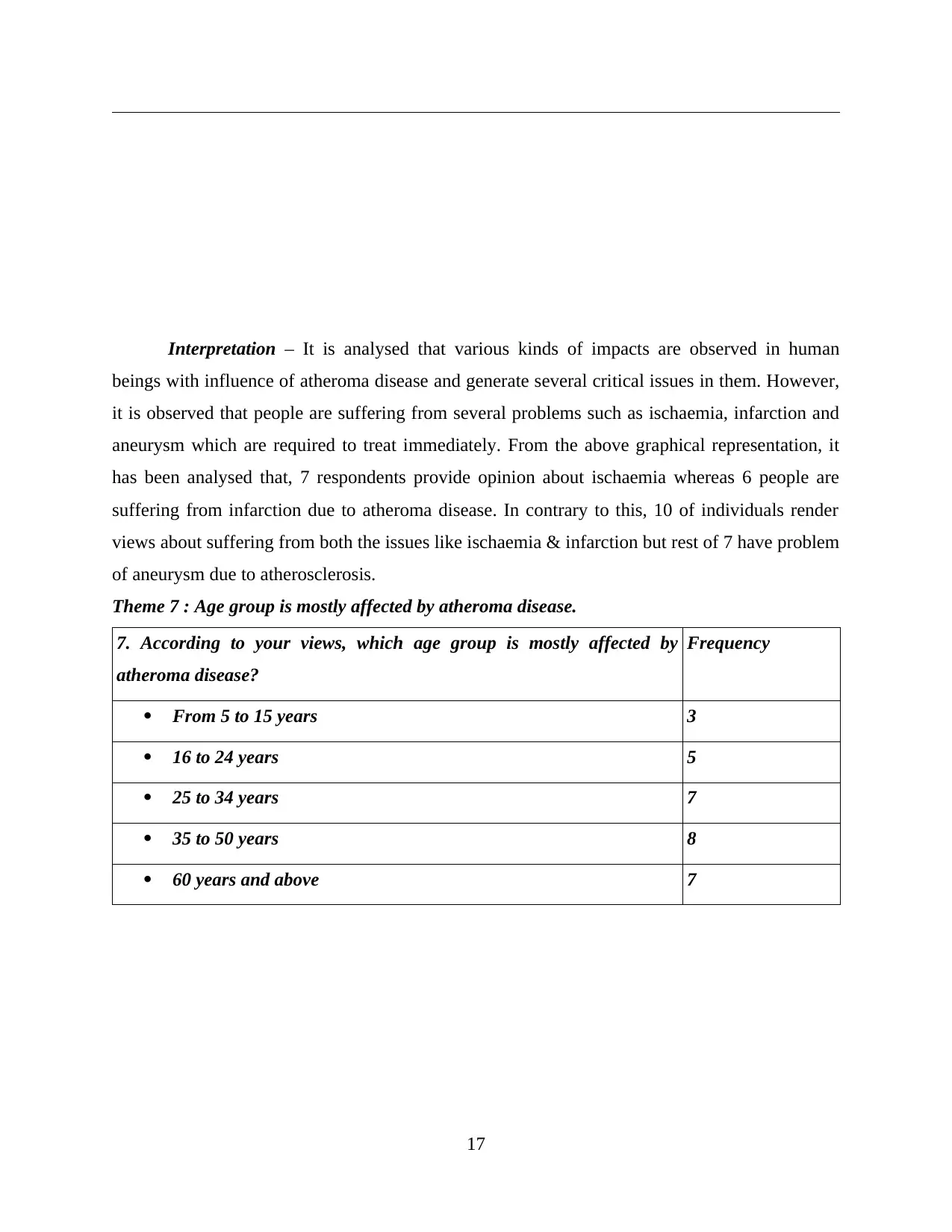
Interpretation – It is analysed that various kinds of impacts are observed in human
beings with influence of atheroma disease and generate several critical issues in them. However,
it is observed that people are suffering from several problems such as ischaemia, infarction and
aneurysm which are required to treat immediately. From the above graphical representation, it
has been analysed that, 7 respondents provide opinion about ischaemia whereas 6 people are
suffering from infarction due to atheroma disease. In contrary to this, 10 of individuals render
views about suffering from both the issues like ischaemia & infarction but rest of 7 have problem
of aneurysm due to atherosclerosis.
Theme 7 : Age group is mostly affected by atheroma disease.
7. According to your views, which age group is mostly affected by
atheroma disease?
Frequency
From 5 to 15 years 3
16 to 24 years 5
25 to 34 years 7
35 to 50 years 8
60 years and above 7
17
beings with influence of atheroma disease and generate several critical issues in them. However,
it is observed that people are suffering from several problems such as ischaemia, infarction and
aneurysm which are required to treat immediately. From the above graphical representation, it
has been analysed that, 7 respondents provide opinion about ischaemia whereas 6 people are
suffering from infarction due to atheroma disease. In contrary to this, 10 of individuals render
views about suffering from both the issues like ischaemia & infarction but rest of 7 have problem
of aneurysm due to atherosclerosis.
Theme 7 : Age group is mostly affected by atheroma disease.
7. According to your views, which age group is mostly affected by
atheroma disease?
Frequency
From 5 to 15 years 3
16 to 24 years 5
25 to 34 years 7
35 to 50 years 8
60 years and above 7
17
Paraphrase This Document
Need a fresh take? Get an instant paraphrase of this document with our AI Paraphraser

Interpretation – The ratio of atheroma disease varies in different types of age groups but
they have various kinds of reasons behind the same. However, atheroma deposition and creating
relevant risk of health issues is slow process and grow slowly and converts into severe situation
after certain period of time. From the above pie chart, 3 of people give views about age group
from 5 to 15 years, 5 individuals have opinion about group of 16 to 24 years and 7 person go
with people with age between 25 to 34 years. At the other hand, 8 respondents provide views
about age group of 35 to 50 years due to atheroma disease whereas rest of 7 go with people
having age 60 years and above.
Theme 8 : Process to bring awareness among public for prevention of atheroma disease.
8. Process to bring awareness among public for prevention of atheroma
disease ?
Frequency
Event launching 10
Social sites 12
Public campaigning 8
18
3
5
7 8
7
From 5 to 15 years
16 to 24 years
25 to 34 years
35 to 50 years
60 years and above
they have various kinds of reasons behind the same. However, atheroma deposition and creating
relevant risk of health issues is slow process and grow slowly and converts into severe situation
after certain period of time. From the above pie chart, 3 of people give views about age group
from 5 to 15 years, 5 individuals have opinion about group of 16 to 24 years and 7 person go
with people with age between 25 to 34 years. At the other hand, 8 respondents provide views
about age group of 35 to 50 years due to atheroma disease whereas rest of 7 go with people
having age 60 years and above.
Theme 8 : Process to bring awareness among public for prevention of atheroma disease.
8. Process to bring awareness among public for prevention of atheroma
disease ?
Frequency
Event launching 10
Social sites 12
Public campaigning 8
18
3
5
7 8
7
From 5 to 15 years
16 to 24 years
25 to 34 years
35 to 50 years
60 years and above
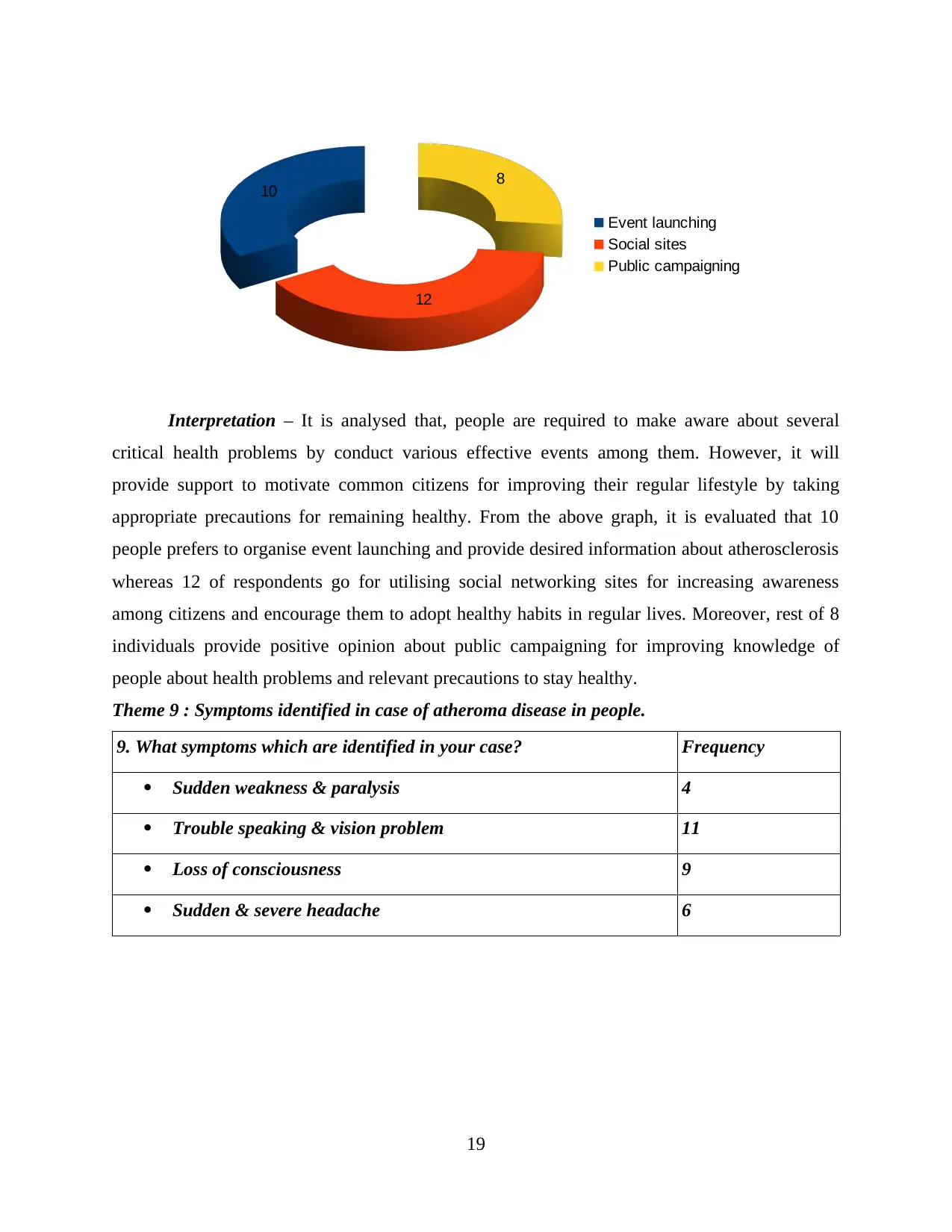
Interpretation – It is analysed that, people are required to make aware about several
critical health problems by conduct various effective events among them. However, it will
provide support to motivate common citizens for improving their regular lifestyle by taking
appropriate precautions for remaining healthy. From the above graph, it is evaluated that 10
people prefers to organise event launching and provide desired information about atherosclerosis
whereas 12 of respondents go for utilising social networking sites for increasing awareness
among citizens and encourage them to adopt healthy habits in regular lives. Moreover, rest of 8
individuals provide positive opinion about public campaigning for improving knowledge of
people about health problems and relevant precautions to stay healthy.
Theme 9 : Symptoms identified in case of atheroma disease in people.
9. What symptoms which are identified in your case? Frequency
Sudden weakness & paralysis 4
Trouble speaking & vision problem 11
Loss of consciousness 9
Sudden & severe headache 6
19
10
12
8
Event launching
Social sites
Public campaigning
critical health problems by conduct various effective events among them. However, it will
provide support to motivate common citizens for improving their regular lifestyle by taking
appropriate precautions for remaining healthy. From the above graph, it is evaluated that 10
people prefers to organise event launching and provide desired information about atherosclerosis
whereas 12 of respondents go for utilising social networking sites for increasing awareness
among citizens and encourage them to adopt healthy habits in regular lives. Moreover, rest of 8
individuals provide positive opinion about public campaigning for improving knowledge of
people about health problems and relevant precautions to stay healthy.
Theme 9 : Symptoms identified in case of atheroma disease in people.
9. What symptoms which are identified in your case? Frequency
Sudden weakness & paralysis 4
Trouble speaking & vision problem 11
Loss of consciousness 9
Sudden & severe headache 6
19
10
12
8
Event launching
Social sites
Public campaigning
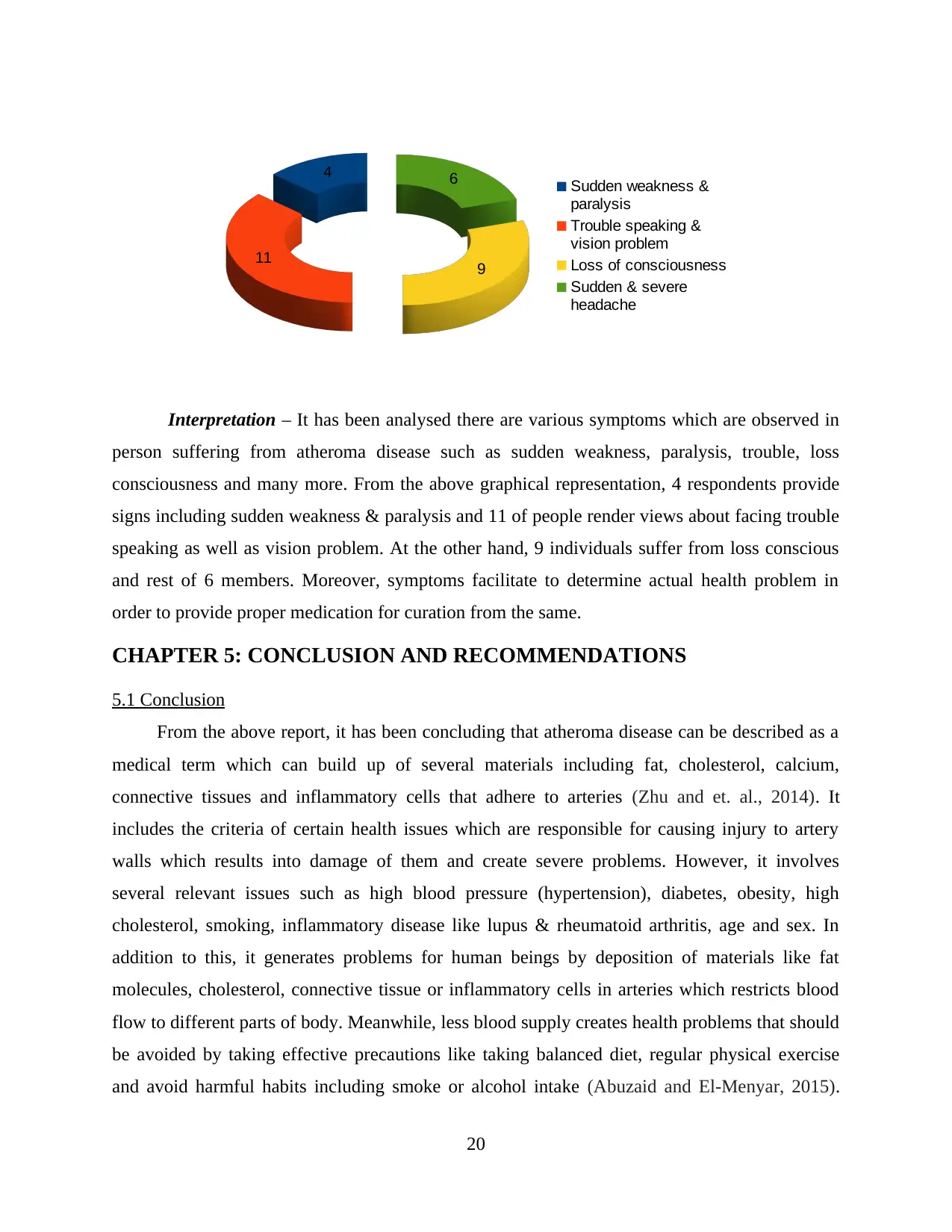
Interpretation – It has been analysed there are various symptoms which are observed in
person suffering from atheroma disease such as sudden weakness, paralysis, trouble, loss
consciousness and many more. From the above graphical representation, 4 respondents provide
signs including sudden weakness & paralysis and 11 of people render views about facing trouble
speaking as well as vision problem. At the other hand, 9 individuals suffer from loss conscious
and rest of 6 members. Moreover, symptoms facilitate to determine actual health problem in
order to provide proper medication for curation from the same.
CHAPTER 5: CONCLUSION AND RECOMMENDATIONS
5.1 Conclusion
From the above report, it has been concluding that atheroma disease can be described as a
medical term which can build up of several materials including fat, cholesterol, calcium,
connective tissues and inflammatory cells that adhere to arteries (Zhu and et. al., 2014). It
includes the criteria of certain health issues which are responsible for causing injury to artery
walls which results into damage of them and create severe problems. However, it involves
several relevant issues such as high blood pressure (hypertension), diabetes, obesity, high
cholesterol, smoking, inflammatory disease like lupus & rheumatoid arthritis, age and sex. In
addition to this, it generates problems for human beings by deposition of materials like fat
molecules, cholesterol, connective tissue or inflammatory cells in arteries which restricts blood
flow to different parts of body. Meanwhile, less blood supply creates health problems that should
be avoided by taking effective precautions like taking balanced diet, regular physical exercise
and avoid harmful habits including smoke or alcohol intake (Abuzaid and El-Menyar, 2015).
20
4
11 9
6 Sudden weakness &
paralysis
Trouble speaking &
vision problem
Loss of consciousness
Sudden & severe
headache
person suffering from atheroma disease such as sudden weakness, paralysis, trouble, loss
consciousness and many more. From the above graphical representation, 4 respondents provide
signs including sudden weakness & paralysis and 11 of people render views about facing trouble
speaking as well as vision problem. At the other hand, 9 individuals suffer from loss conscious
and rest of 6 members. Moreover, symptoms facilitate to determine actual health problem in
order to provide proper medication for curation from the same.
CHAPTER 5: CONCLUSION AND RECOMMENDATIONS
5.1 Conclusion
From the above report, it has been concluding that atheroma disease can be described as a
medical term which can build up of several materials including fat, cholesterol, calcium,
connective tissues and inflammatory cells that adhere to arteries (Zhu and et. al., 2014). It
includes the criteria of certain health issues which are responsible for causing injury to artery
walls which results into damage of them and create severe problems. However, it involves
several relevant issues such as high blood pressure (hypertension), diabetes, obesity, high
cholesterol, smoking, inflammatory disease like lupus & rheumatoid arthritis, age and sex. In
addition to this, it generates problems for human beings by deposition of materials like fat
molecules, cholesterol, connective tissue or inflammatory cells in arteries which restricts blood
flow to different parts of body. Meanwhile, less blood supply creates health problems that should
be avoided by taking effective precautions like taking balanced diet, regular physical exercise
and avoid harmful habits including smoke or alcohol intake (Abuzaid and El-Menyar, 2015).
20
4
11 9
6 Sudden weakness &
paralysis
Trouble speaking &
vision problem
Loss of consciousness
Sudden & severe
headache
Secure Best Marks with AI Grader
Need help grading? Try our AI Grader for instant feedback on your assignments.
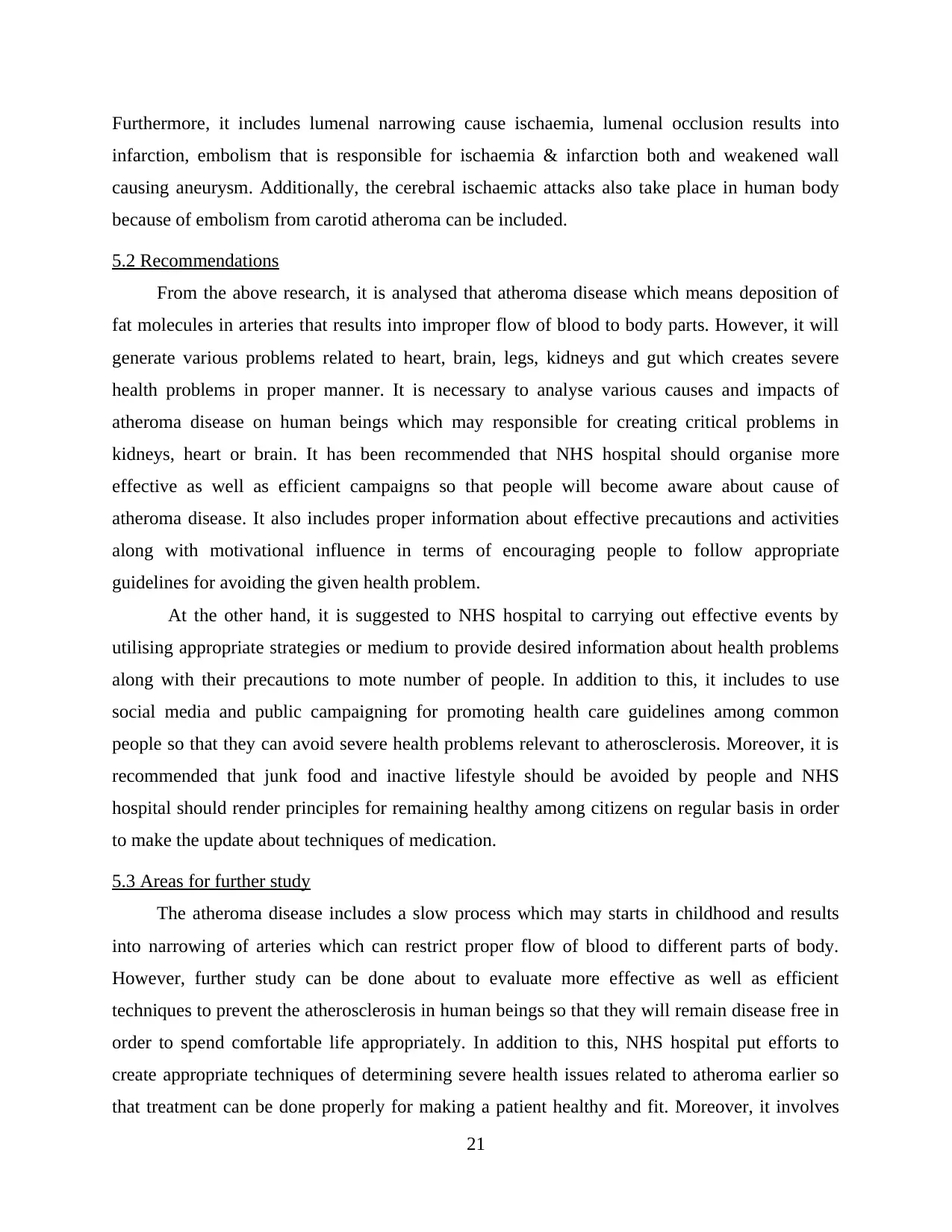
Furthermore, it includes lumenal narrowing cause ischaemia, lumenal occlusion results into
infarction, embolism that is responsible for ischaemia & infarction both and weakened wall
causing aneurysm. Additionally, the cerebral ischaemic attacks also take place in human body
because of embolism from carotid atheroma can be included.
5.2 Recommendations
From the above research, it is analysed that atheroma disease which means deposition of
fat molecules in arteries that results into improper flow of blood to body parts. However, it will
generate various problems related to heart, brain, legs, kidneys and gut which creates severe
health problems in proper manner. It is necessary to analyse various causes and impacts of
atheroma disease on human beings which may responsible for creating critical problems in
kidneys, heart or brain. It has been recommended that NHS hospital should organise more
effective as well as efficient campaigns so that people will become aware about cause of
atheroma disease. It also includes proper information about effective precautions and activities
along with motivational influence in terms of encouraging people to follow appropriate
guidelines for avoiding the given health problem.
At the other hand, it is suggested to NHS hospital to carrying out effective events by
utilising appropriate strategies or medium to provide desired information about health problems
along with their precautions to mote number of people. In addition to this, it includes to use
social media and public campaigning for promoting health care guidelines among common
people so that they can avoid severe health problems relevant to atherosclerosis. Moreover, it is
recommended that junk food and inactive lifestyle should be avoided by people and NHS
hospital should render principles for remaining healthy among citizens on regular basis in order
to make the update about techniques of medication.
5.3 Areas for further study
The atheroma disease includes a slow process which may starts in childhood and results
into narrowing of arteries which can restrict proper flow of blood to different parts of body.
However, further study can be done about to evaluate more effective as well as efficient
techniques to prevent the atherosclerosis in human beings so that they will remain disease free in
order to spend comfortable life appropriately. In addition to this, NHS hospital put efforts to
create appropriate techniques of determining severe health issues related to atheroma earlier so
that treatment can be done properly for making a patient healthy and fit. Moreover, it involves
21
infarction, embolism that is responsible for ischaemia & infarction both and weakened wall
causing aneurysm. Additionally, the cerebral ischaemic attacks also take place in human body
because of embolism from carotid atheroma can be included.
5.2 Recommendations
From the above research, it is analysed that atheroma disease which means deposition of
fat molecules in arteries that results into improper flow of blood to body parts. However, it will
generate various problems related to heart, brain, legs, kidneys and gut which creates severe
health problems in proper manner. It is necessary to analyse various causes and impacts of
atheroma disease on human beings which may responsible for creating critical problems in
kidneys, heart or brain. It has been recommended that NHS hospital should organise more
effective as well as efficient campaigns so that people will become aware about cause of
atheroma disease. It also includes proper information about effective precautions and activities
along with motivational influence in terms of encouraging people to follow appropriate
guidelines for avoiding the given health problem.
At the other hand, it is suggested to NHS hospital to carrying out effective events by
utilising appropriate strategies or medium to provide desired information about health problems
along with their precautions to mote number of people. In addition to this, it includes to use
social media and public campaigning for promoting health care guidelines among common
people so that they can avoid severe health problems relevant to atherosclerosis. Moreover, it is
recommended that junk food and inactive lifestyle should be avoided by people and NHS
hospital should render principles for remaining healthy among citizens on regular basis in order
to make the update about techniques of medication.
5.3 Areas for further study
The atheroma disease includes a slow process which may starts in childhood and results
into narrowing of arteries which can restrict proper flow of blood to different parts of body.
However, further study can be done about to evaluate more effective as well as efficient
techniques to prevent the atherosclerosis in human beings so that they will remain disease free in
order to spend comfortable life appropriately. In addition to this, NHS hospital put efforts to
create appropriate techniques of determining severe health issues related to atheroma earlier so
that treatment can be done properly for making a patient healthy and fit. Moreover, it involves
21
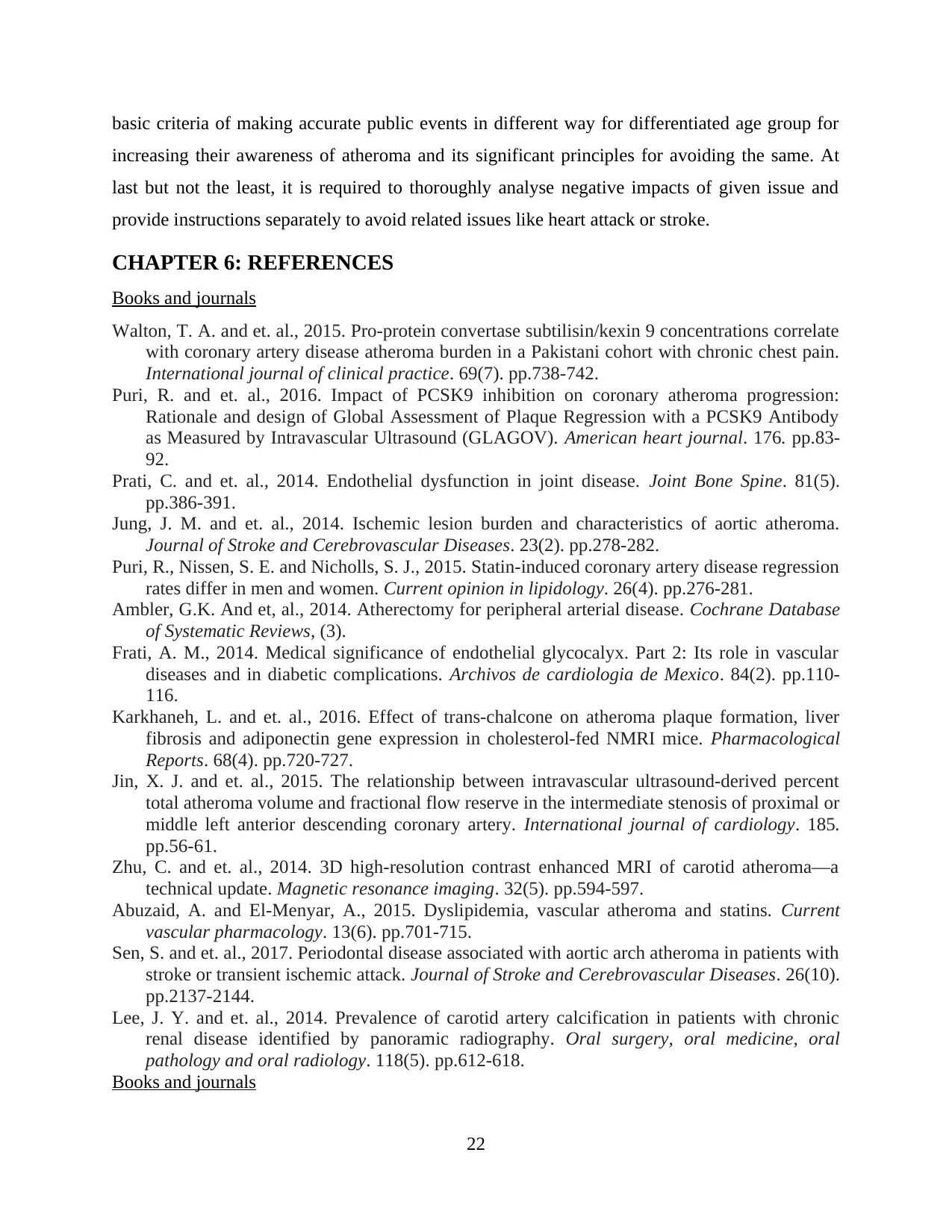
basic criteria of making accurate public events in different way for differentiated age group for
increasing their awareness of atheroma and its significant principles for avoiding the same. At
last but not the least, it is required to thoroughly analyse negative impacts of given issue and
provide instructions separately to avoid related issues like heart attack or stroke.
CHAPTER 6: REFERENCES
Books and journals
Walton, T. A. and et. al., 2015. Pro‐protein convertase subtilisin/kexin 9 concentrations correlate
with coronary artery disease atheroma burden in a Pakistani cohort with chronic chest pain.
International journal of clinical practice. 69(7). pp.738-742.
Puri, R. and et. al., 2016. Impact of PCSK9 inhibition on coronary atheroma progression:
Rationale and design of Global Assessment of Plaque Regression with a PCSK9 Antibody
as Measured by Intravascular Ultrasound (GLAGOV). American heart journal. 176. pp.83-
92.
Prati, C. and et. al., 2014. Endothelial dysfunction in joint disease. Joint Bone Spine. 81(5).
pp.386-391.
Jung, J. M. and et. al., 2014. Ischemic lesion burden and characteristics of aortic atheroma.
Journal of Stroke and Cerebrovascular Diseases. 23(2). pp.278-282.
Puri, R., Nissen, S. E. and Nicholls, S. J., 2015. Statin-induced coronary artery disease regression
rates differ in men and women. Current opinion in lipidology. 26(4). pp.276-281.
Ambler, G.K. And et, al., 2014. Atherectomy for peripheral arterial disease. Cochrane Database
of Systematic Reviews, (3).
Frati, A. M., 2014. Medical significance of endothelial glycocalyx. Part 2: Its role in vascular
diseases and in diabetic complications. Archivos de cardiologia de Mexico. 84(2). pp.110-
116.
Karkhaneh, L. and et. al., 2016. Effect of trans-chalcone on atheroma plaque formation, liver
fibrosis and adiponectin gene expression in cholesterol-fed NMRI mice. Pharmacological
Reports. 68(4). pp.720-727.
Jin, X. J. and et. al., 2015. The relationship between intravascular ultrasound-derived percent
total atheroma volume and fractional flow reserve in the intermediate stenosis of proximal or
middle left anterior descending coronary artery. International journal of cardiology. 185.
pp.56-61.
Zhu, C. and et. al., 2014. 3D high-resolution contrast enhanced MRI of carotid atheroma—a
technical update. Magnetic resonance imaging. 32(5). pp.594-597.
Abuzaid, A. and El-Menyar, A., 2015. Dyslipidemia, vascular atheroma and statins. Current
vascular pharmacology. 13(6). pp.701-715.
Sen, S. and et. al., 2017. Periodontal disease associated with aortic arch atheroma in patients with
stroke or transient ischemic attack. Journal of Stroke and Cerebrovascular Diseases. 26(10).
pp.2137-2144.
Lee, J. Y. and et. al., 2014. Prevalence of carotid artery calcification in patients with chronic
renal disease identified by panoramic radiography. Oral surgery, oral medicine, oral
pathology and oral radiology. 118(5). pp.612-618.
Books and journals
22
increasing their awareness of atheroma and its significant principles for avoiding the same. At
last but not the least, it is required to thoroughly analyse negative impacts of given issue and
provide instructions separately to avoid related issues like heart attack or stroke.
CHAPTER 6: REFERENCES
Books and journals
Walton, T. A. and et. al., 2015. Pro‐protein convertase subtilisin/kexin 9 concentrations correlate
with coronary artery disease atheroma burden in a Pakistani cohort with chronic chest pain.
International journal of clinical practice. 69(7). pp.738-742.
Puri, R. and et. al., 2016. Impact of PCSK9 inhibition on coronary atheroma progression:
Rationale and design of Global Assessment of Plaque Regression with a PCSK9 Antibody
as Measured by Intravascular Ultrasound (GLAGOV). American heart journal. 176. pp.83-
92.
Prati, C. and et. al., 2014. Endothelial dysfunction in joint disease. Joint Bone Spine. 81(5).
pp.386-391.
Jung, J. M. and et. al., 2014. Ischemic lesion burden and characteristics of aortic atheroma.
Journal of Stroke and Cerebrovascular Diseases. 23(2). pp.278-282.
Puri, R., Nissen, S. E. and Nicholls, S. J., 2015. Statin-induced coronary artery disease regression
rates differ in men and women. Current opinion in lipidology. 26(4). pp.276-281.
Ambler, G.K. And et, al., 2014. Atherectomy for peripheral arterial disease. Cochrane Database
of Systematic Reviews, (3).
Frati, A. M., 2014. Medical significance of endothelial glycocalyx. Part 2: Its role in vascular
diseases and in diabetic complications. Archivos de cardiologia de Mexico. 84(2). pp.110-
116.
Karkhaneh, L. and et. al., 2016. Effect of trans-chalcone on atheroma plaque formation, liver
fibrosis and adiponectin gene expression in cholesterol-fed NMRI mice. Pharmacological
Reports. 68(4). pp.720-727.
Jin, X. J. and et. al., 2015. The relationship between intravascular ultrasound-derived percent
total atheroma volume and fractional flow reserve in the intermediate stenosis of proximal or
middle left anterior descending coronary artery. International journal of cardiology. 185.
pp.56-61.
Zhu, C. and et. al., 2014. 3D high-resolution contrast enhanced MRI of carotid atheroma—a
technical update. Magnetic resonance imaging. 32(5). pp.594-597.
Abuzaid, A. and El-Menyar, A., 2015. Dyslipidemia, vascular atheroma and statins. Current
vascular pharmacology. 13(6). pp.701-715.
Sen, S. and et. al., 2017. Periodontal disease associated with aortic arch atheroma in patients with
stroke or transient ischemic attack. Journal of Stroke and Cerebrovascular Diseases. 26(10).
pp.2137-2144.
Lee, J. Y. and et. al., 2014. Prevalence of carotid artery calcification in patients with chronic
renal disease identified by panoramic radiography. Oral surgery, oral medicine, oral
pathology and oral radiology. 118(5). pp.612-618.
Books and journals
22
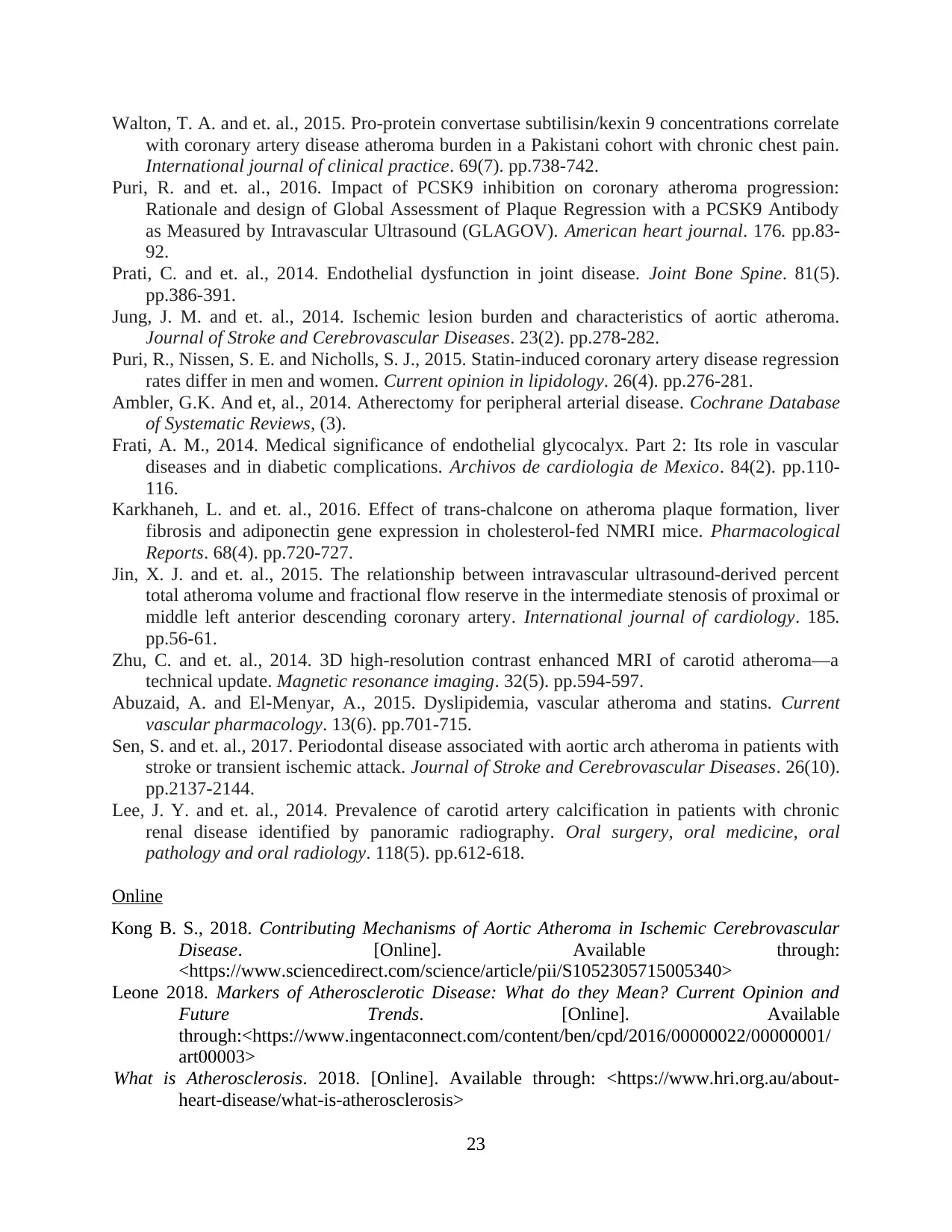
Walton, T. A. and et. al., 2015. Pro‐protein convertase subtilisin/kexin 9 concentrations correlate
with coronary artery disease atheroma burden in a Pakistani cohort with chronic chest pain.
International journal of clinical practice. 69(7). pp.738-742.
Puri, R. and et. al., 2016. Impact of PCSK9 inhibition on coronary atheroma progression:
Rationale and design of Global Assessment of Plaque Regression with a PCSK9 Antibody
as Measured by Intravascular Ultrasound (GLAGOV). American heart journal. 176. pp.83-
92.
Prati, C. and et. al., 2014. Endothelial dysfunction in joint disease. Joint Bone Spine. 81(5).
pp.386-391.
Jung, J. M. and et. al., 2014. Ischemic lesion burden and characteristics of aortic atheroma.
Journal of Stroke and Cerebrovascular Diseases. 23(2). pp.278-282.
Puri, R., Nissen, S. E. and Nicholls, S. J., 2015. Statin-induced coronary artery disease regression
rates differ in men and women. Current opinion in lipidology. 26(4). pp.276-281.
Ambler, G.K. And et, al., 2014. Atherectomy for peripheral arterial disease. Cochrane Database
of Systematic Reviews, (3).
Frati, A. M., 2014. Medical significance of endothelial glycocalyx. Part 2: Its role in vascular
diseases and in diabetic complications. Archivos de cardiologia de Mexico. 84(2). pp.110-
116.
Karkhaneh, L. and et. al., 2016. Effect of trans-chalcone on atheroma plaque formation, liver
fibrosis and adiponectin gene expression in cholesterol-fed NMRI mice. Pharmacological
Reports. 68(4). pp.720-727.
Jin, X. J. and et. al., 2015. The relationship between intravascular ultrasound-derived percent
total atheroma volume and fractional flow reserve in the intermediate stenosis of proximal or
middle left anterior descending coronary artery. International journal of cardiology. 185.
pp.56-61.
Zhu, C. and et. al., 2014. 3D high-resolution contrast enhanced MRI of carotid atheroma—a
technical update. Magnetic resonance imaging. 32(5). pp.594-597.
Abuzaid, A. and El-Menyar, A., 2015. Dyslipidemia, vascular atheroma and statins. Current
vascular pharmacology. 13(6). pp.701-715.
Sen, S. and et. al., 2017. Periodontal disease associated with aortic arch atheroma in patients with
stroke or transient ischemic attack. Journal of Stroke and Cerebrovascular Diseases. 26(10).
pp.2137-2144.
Lee, J. Y. and et. al., 2014. Prevalence of carotid artery calcification in patients with chronic
renal disease identified by panoramic radiography. Oral surgery, oral medicine, oral
pathology and oral radiology. 118(5). pp.612-618.
Online
Kong B. S., 2018. Contributing Mechanisms of Aortic Atheroma in Ischemic Cerebrovascular
Disease. [Online]. Available through:
<https://www.sciencedirect.com/science/article/pii/S1052305715005340>
Leone 2018. Markers of Atherosclerotic Disease: What do they Mean? Current Opinion and
Future Trends. [Online]. Available
through:<https://www.ingentaconnect.com/content/ben/cpd/2016/00000022/00000001/
art00003>
What is Atherosclerosis. 2018. [Online]. Available through: <https://www.hri.org.au/about-
heart-disease/what-is-atherosclerosis>
23
with coronary artery disease atheroma burden in a Pakistani cohort with chronic chest pain.
International journal of clinical practice. 69(7). pp.738-742.
Puri, R. and et. al., 2016. Impact of PCSK9 inhibition on coronary atheroma progression:
Rationale and design of Global Assessment of Plaque Regression with a PCSK9 Antibody
as Measured by Intravascular Ultrasound (GLAGOV). American heart journal. 176. pp.83-
92.
Prati, C. and et. al., 2014. Endothelial dysfunction in joint disease. Joint Bone Spine. 81(5).
pp.386-391.
Jung, J. M. and et. al., 2014. Ischemic lesion burden and characteristics of aortic atheroma.
Journal of Stroke and Cerebrovascular Diseases. 23(2). pp.278-282.
Puri, R., Nissen, S. E. and Nicholls, S. J., 2015. Statin-induced coronary artery disease regression
rates differ in men and women. Current opinion in lipidology. 26(4). pp.276-281.
Ambler, G.K. And et, al., 2014. Atherectomy for peripheral arterial disease. Cochrane Database
of Systematic Reviews, (3).
Frati, A. M., 2014. Medical significance of endothelial glycocalyx. Part 2: Its role in vascular
diseases and in diabetic complications. Archivos de cardiologia de Mexico. 84(2). pp.110-
116.
Karkhaneh, L. and et. al., 2016. Effect of trans-chalcone on atheroma plaque formation, liver
fibrosis and adiponectin gene expression in cholesterol-fed NMRI mice. Pharmacological
Reports. 68(4). pp.720-727.
Jin, X. J. and et. al., 2015. The relationship between intravascular ultrasound-derived percent
total atheroma volume and fractional flow reserve in the intermediate stenosis of proximal or
middle left anterior descending coronary artery. International journal of cardiology. 185.
pp.56-61.
Zhu, C. and et. al., 2014. 3D high-resolution contrast enhanced MRI of carotid atheroma—a
technical update. Magnetic resonance imaging. 32(5). pp.594-597.
Abuzaid, A. and El-Menyar, A., 2015. Dyslipidemia, vascular atheroma and statins. Current
vascular pharmacology. 13(6). pp.701-715.
Sen, S. and et. al., 2017. Periodontal disease associated with aortic arch atheroma in patients with
stroke or transient ischemic attack. Journal of Stroke and Cerebrovascular Diseases. 26(10).
pp.2137-2144.
Lee, J. Y. and et. al., 2014. Prevalence of carotid artery calcification in patients with chronic
renal disease identified by panoramic radiography. Oral surgery, oral medicine, oral
pathology and oral radiology. 118(5). pp.612-618.
Online
Kong B. S., 2018. Contributing Mechanisms of Aortic Atheroma in Ischemic Cerebrovascular
Disease. [Online]. Available through:
<https://www.sciencedirect.com/science/article/pii/S1052305715005340>
Leone 2018. Markers of Atherosclerotic Disease: What do they Mean? Current Opinion and
Future Trends. [Online]. Available
through:<https://www.ingentaconnect.com/content/ben/cpd/2016/00000022/00000001/
art00003>
What is Atherosclerosis. 2018. [Online]. Available through: <https://www.hri.org.au/about-
heart-disease/what-is-atherosclerosis>
23
Paraphrase This Document
Need a fresh take? Get an instant paraphrase of this document with our AI Paraphraser
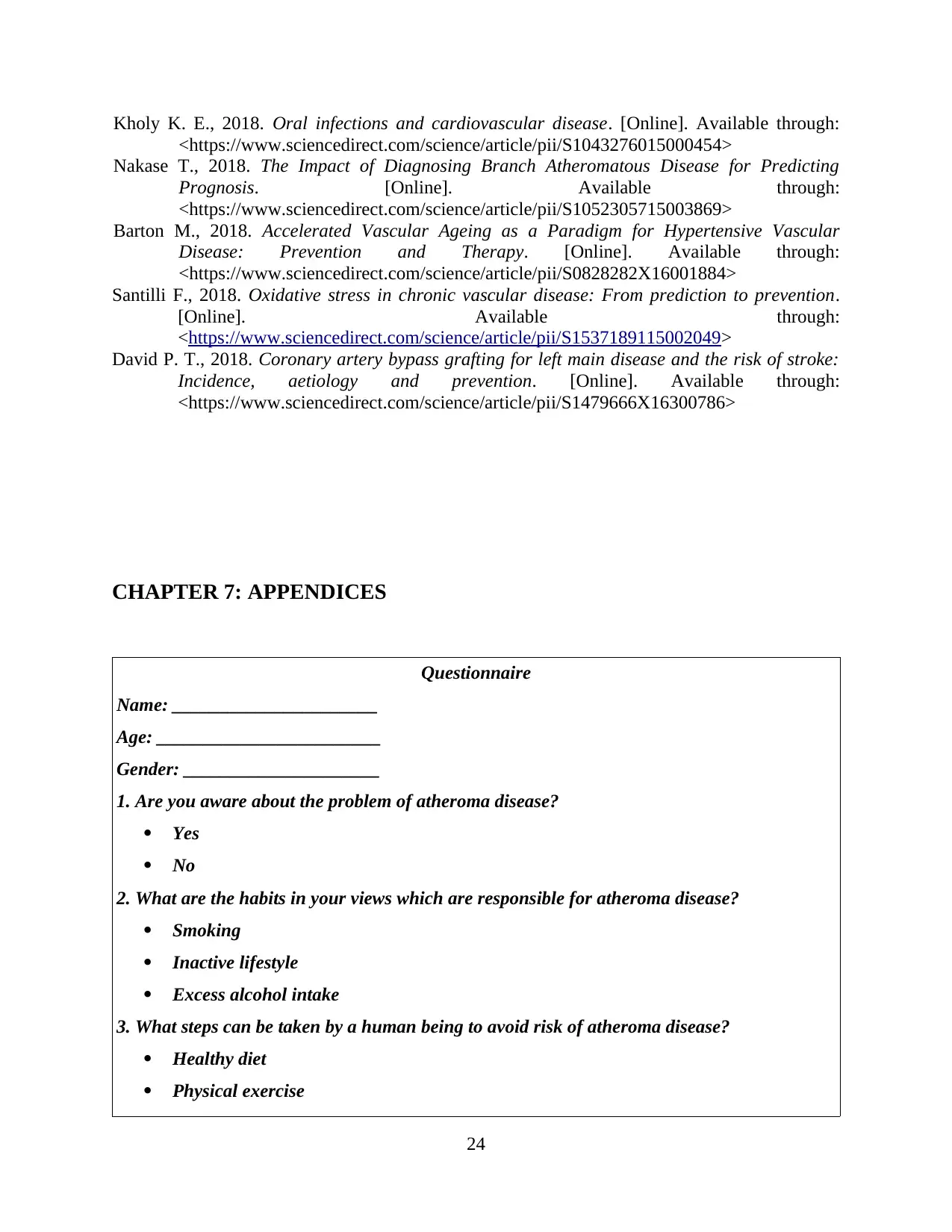
Kholy K. E., 2018. Oral infections and cardiovascular disease. [Online]. Available through:
<https://www.sciencedirect.com/science/article/pii/S1043276015000454>
Nakase T., 2018. The Impact of Diagnosing Branch Atheromatous Disease for Predicting
Prognosis. [Online]. Available through:
<https://www.sciencedirect.com/science/article/pii/S1052305715003869>
Barton M., 2018. Accelerated Vascular Ageing as a Paradigm for Hypertensive Vascular
Disease: Prevention and Therapy. [Online]. Available through:
<https://www.sciencedirect.com/science/article/pii/S0828282X16001884>
Santilli F., 2018. Oxidative stress in chronic vascular disease: From prediction to prevention.
[Online]. Available through:
<https://www.sciencedirect.com/science/article/pii/S1537189115002049>
David P. T., 2018. Coronary artery bypass grafting for left main disease and the risk of stroke:
Incidence, aetiology and prevention. [Online]. Available through:
<https://www.sciencedirect.com/science/article/pii/S1479666X16300786>
CHAPTER 7: APPENDICES
Questionnaire
Name: ______________________
Age: ________________________
Gender: _____________________
1. Are you aware about the problem of atheroma disease?
Yes
No
2. What are the habits in your views which are responsible for atheroma disease?
Smoking
Inactive lifestyle
Excess alcohol intake
3. What steps can be taken by a human being to avoid risk of atheroma disease?
Healthy diet
Physical exercise
24
<https://www.sciencedirect.com/science/article/pii/S1043276015000454>
Nakase T., 2018. The Impact of Diagnosing Branch Atheromatous Disease for Predicting
Prognosis. [Online]. Available through:
<https://www.sciencedirect.com/science/article/pii/S1052305715003869>
Barton M., 2018. Accelerated Vascular Ageing as a Paradigm for Hypertensive Vascular
Disease: Prevention and Therapy. [Online]. Available through:
<https://www.sciencedirect.com/science/article/pii/S0828282X16001884>
Santilli F., 2018. Oxidative stress in chronic vascular disease: From prediction to prevention.
[Online]. Available through:
<https://www.sciencedirect.com/science/article/pii/S1537189115002049>
David P. T., 2018. Coronary artery bypass grafting for left main disease and the risk of stroke:
Incidence, aetiology and prevention. [Online]. Available through:
<https://www.sciencedirect.com/science/article/pii/S1479666X16300786>
CHAPTER 7: APPENDICES
Questionnaire
Name: ______________________
Age: ________________________
Gender: _____________________
1. Are you aware about the problem of atheroma disease?
Yes
No
2. What are the habits in your views which are responsible for atheroma disease?
Smoking
Inactive lifestyle
Excess alcohol intake
3. What steps can be taken by a human being to avoid risk of atheroma disease?
Healthy diet
Physical exercise
24
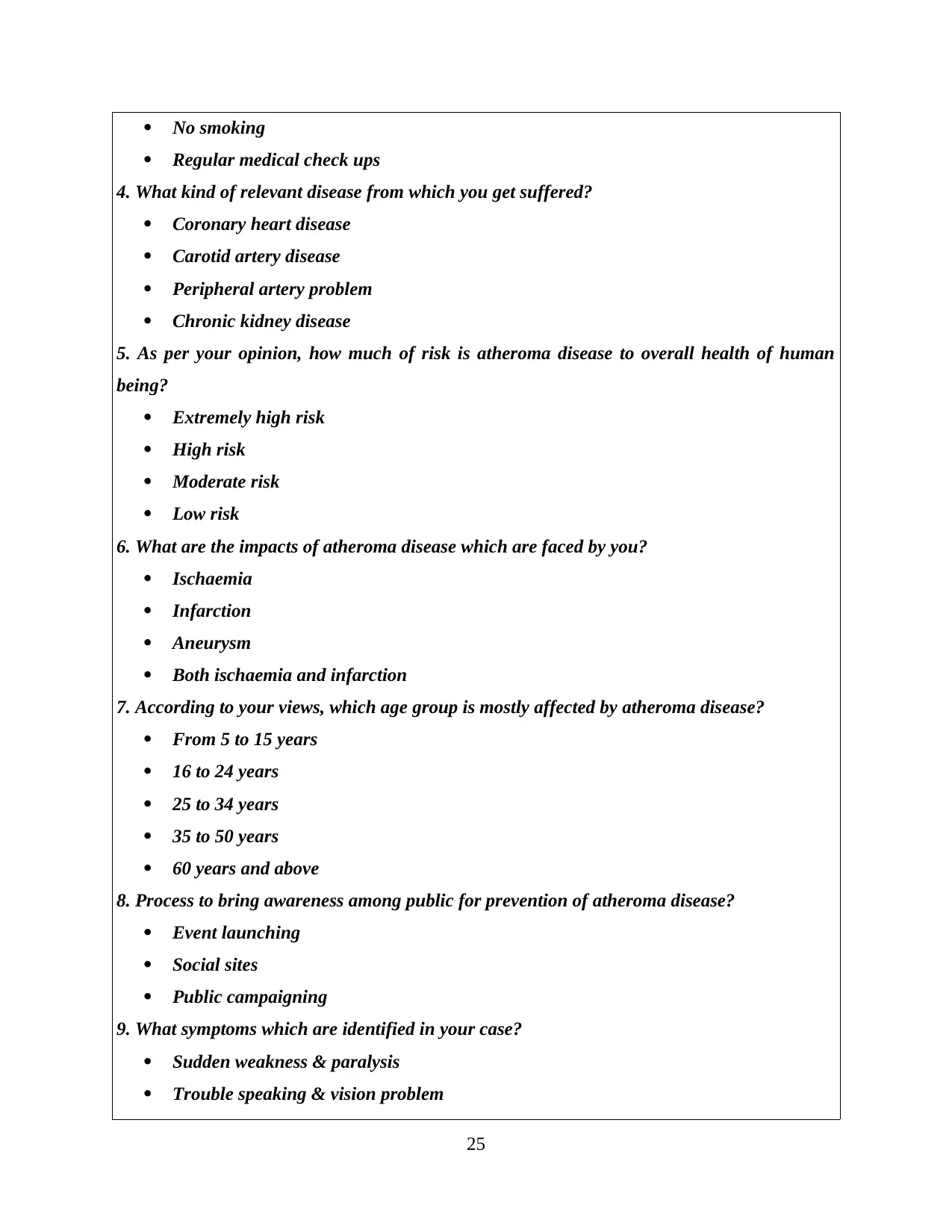
No smoking
Regular medical check ups
4. What kind of relevant disease from which you get suffered?
Coronary heart disease
Carotid artery disease
Peripheral artery problem
Chronic kidney disease
5. As per your opinion, how much of risk is atheroma disease to overall health of human
being?
Extremely high risk
High risk
Moderate risk
Low risk
6. What are the impacts of atheroma disease which are faced by you?
Ischaemia
Infarction
Aneurysm
Both ischaemia and infarction
7. According to your views, which age group is mostly affected by atheroma disease?
From 5 to 15 years
16 to 24 years
25 to 34 years
35 to 50 years
60 years and above
8. Process to bring awareness among public for prevention of atheroma disease?
Event launching
Social sites
Public campaigning
9. What symptoms which are identified in your case?
Sudden weakness & paralysis
Trouble speaking & vision problem
25
Regular medical check ups
4. What kind of relevant disease from which you get suffered?
Coronary heart disease
Carotid artery disease
Peripheral artery problem
Chronic kidney disease
5. As per your opinion, how much of risk is atheroma disease to overall health of human
being?
Extremely high risk
High risk
Moderate risk
Low risk
6. What are the impacts of atheroma disease which are faced by you?
Ischaemia
Infarction
Aneurysm
Both ischaemia and infarction
7. According to your views, which age group is mostly affected by atheroma disease?
From 5 to 15 years
16 to 24 years
25 to 34 years
35 to 50 years
60 years and above
8. Process to bring awareness among public for prevention of atheroma disease?
Event launching
Social sites
Public campaigning
9. What symptoms which are identified in your case?
Sudden weakness & paralysis
Trouble speaking & vision problem
25
1 out of 27
Related Documents
Your All-in-One AI-Powered Toolkit for Academic Success.
+13062052269
info@desklib.com
Available 24*7 on WhatsApp / Email
![[object Object]](/_next/static/media/star-bottom.7253800d.svg)
Unlock your academic potential
© 2024 | Zucol Services PVT LTD | All rights reserved.




